Introduction
Alphacool NexXxos ST30 280mm Radiator Review
Welcome to another Extreme Rigs 280mm radiator review. After just finishing up with the Monsta 280 which is the thickest 280mm radiator of the test group, today we’ll be looking at the thinnest. The NexXxos ST30 280mm from Alphacool measures in with a thickness of a mere 29.5mm and will therefore be of interest to a completely different group of potential buyers.
The ST30 280 is one of 12 different ST30 size radiators available in the 30mm thick range offered by Alphacool. In our review of the ST30 280 we’ll take a close look at it’s construction & quality, analyze the performance data by comparing it’s results against other 280mm radiators and then conclude with a summary.
An interesting reference for some readers/potential buyers will be our review of the ST30 360mm which we published last year. While not a true 1:1 comparison because of the different size/performance fans used for testing 120.x and 140.x radiators, we’ll pull some of the ST30 360 data and compare against the ST30 280 later on.
Firstly a big thanks to Aqua Tuning for providing the review sample of the Alphacool ST30 280mm. Since we commenced our radiator testing, Aqua Tuning’s commitment to our independent tests has been second to none. Extreme Rigs couldn’t publish the reviews we do without the continued support offered by our sponsors, so a big thanks to all the crew at Aqua Tuning and Alphacool.
Before we start we would again like to say thanks to Noctua for providing the NF-A14 Industrial PPC-2000 IP67 PWM 140mm fans. We use these fans for all our 140mm based radiator thermal performance testing because they have great static pressure which is required to get the best performance from even densest of radiator cores and of course, their proven reliability.
What’s in the Box?
The ST30 280 sample arrived in full retail packaging.
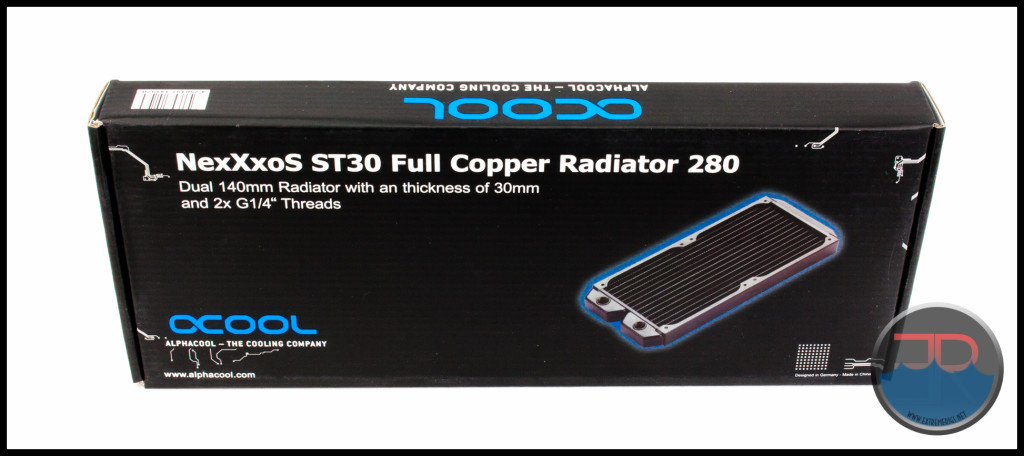 The front and back are almost identical and feature an image of the radiator along with the model and company logo.
The front and back are almost identical and feature an image of the radiator along with the model and company logo.
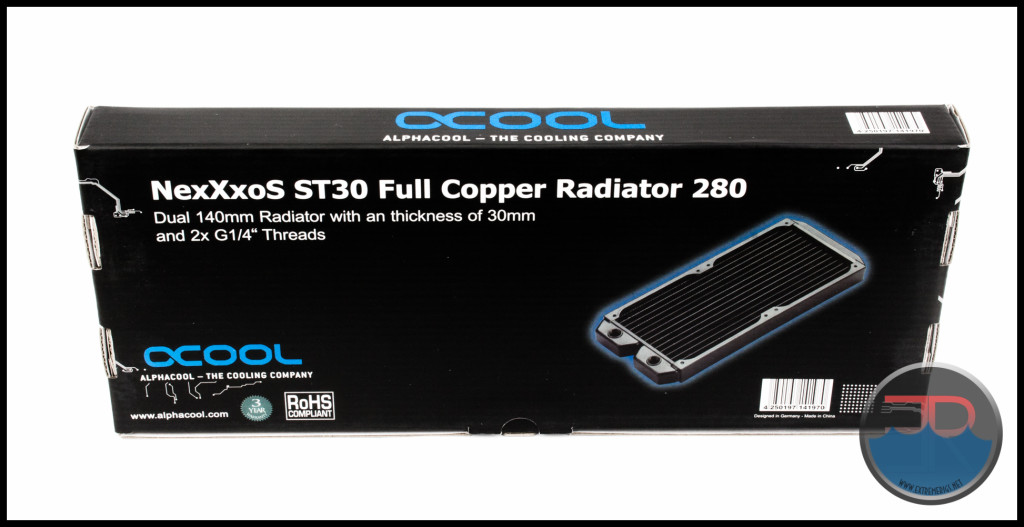 Opening the box, we see the usual packing layout for Alphacool radiators. Alphacool really do a great job in ensuring that their radiators have every chance of arriving to the purchaser in the best possible condition.
Opening the box, we see the usual packing layout for Alphacool radiators. Alphacool really do a great job in ensuring that their radiators have every chance of arriving to the purchaser in the best possible condition.
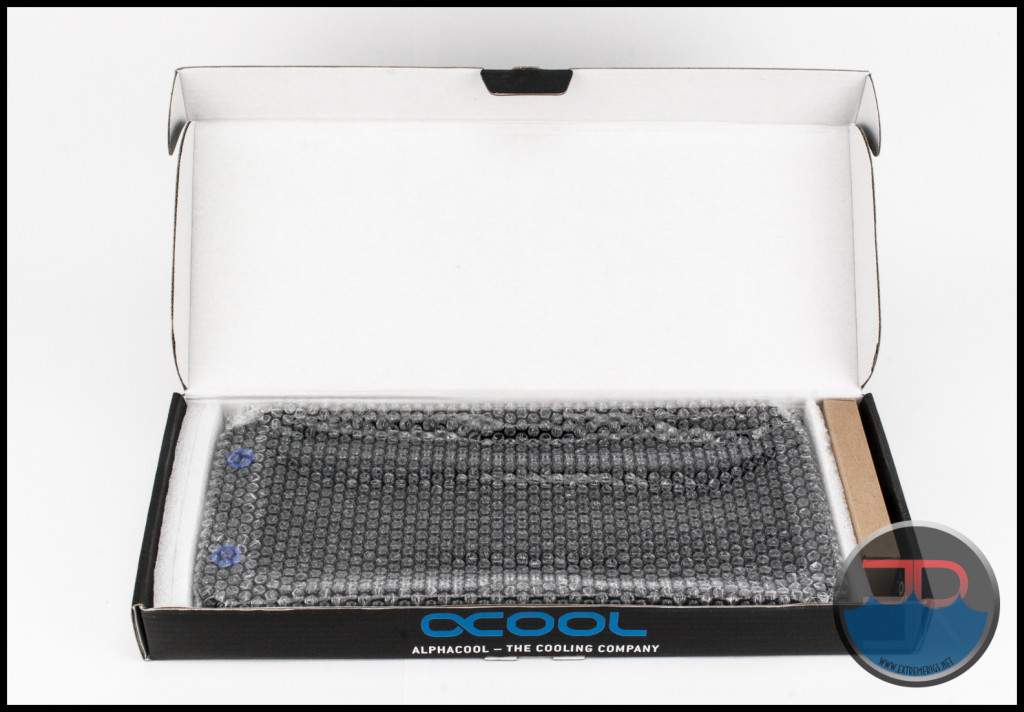 As always, we are happy to see a bubble wrap sleeve to protect the paint finish from scuffing during transport and the foam pieces at each end keep the radiator from sliding about.
As always, we are happy to see a bubble wrap sleeve to protect the paint finish from scuffing during transport and the foam pieces at each end keep the radiator from sliding about.
Placing the accessories in a separate box at one end of the package tops off what is a simple yet effective packaging layout.
Extent of delivery as listed by Alphacool:
“1x Radiator
8x Copper-plated M3x30mm hexagon socket screw
8x Copper-plated M3x35mm hexagon socket screw”
It’s interesting that Alphacool have not updated their info since changing from the copper plated screws to the black ones which are now supplied. Aqua Tuning appear more up to date with their ST30 280 product page. having the following listed as being included:
“1x Radiator
8x M3x30mm hexagon socket screw
8x M3x35mm hexagon socket screw”
In the previous photos we saw a brown box which contains the accessories that are supplied with the ST30 280. Inside there are 4 small bags in total, each of which contain a set of 4 screws and an unmentioned Allen Key.
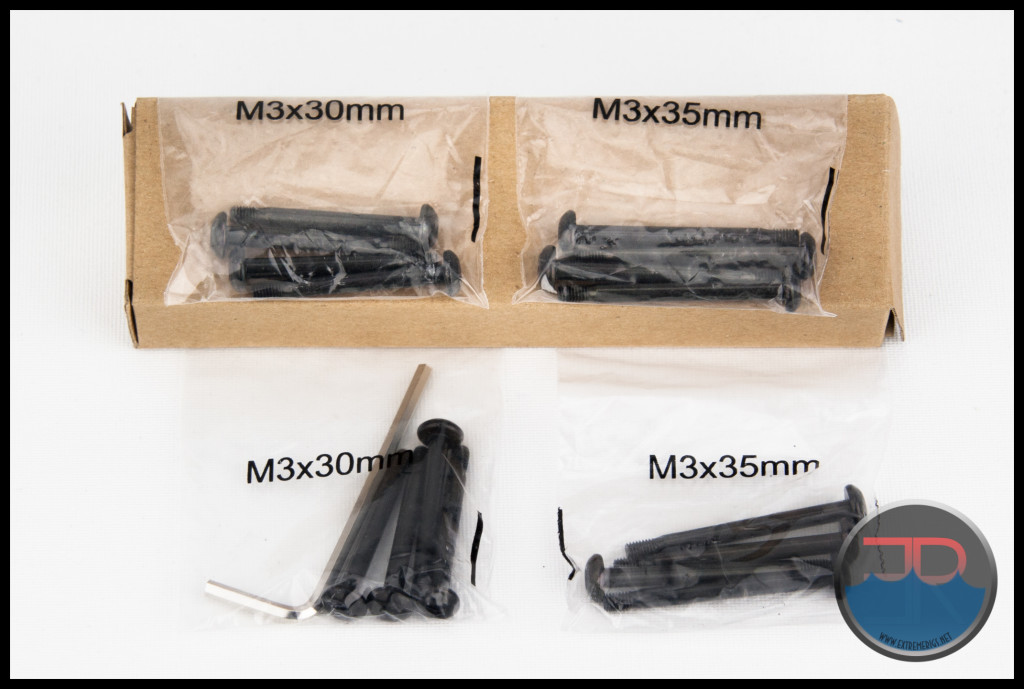
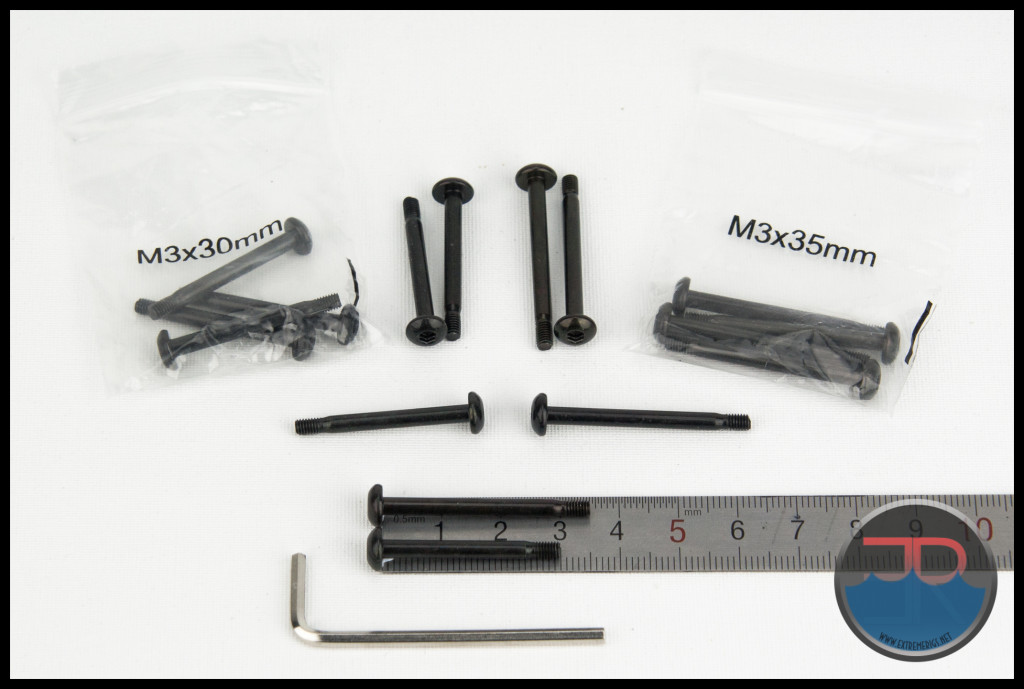
The shorter screws measure in at 30mm, while the longer ones are 35mm. Each screw has ~5mm of thread before a solid and thicker shank up to the button head, hex key heads.
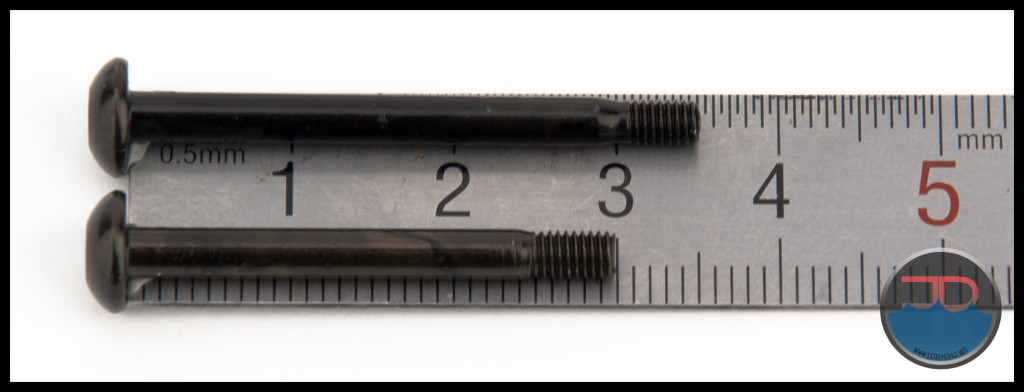 8 screws of each length are provided, so there are enough to fit the radiator with either a Push Only, Pull Only OR Push/Pull fan assembly straight from the box. BUT as seen below the 35mm are really too long to be used without a grill/case panel and decoupling of some kind.
8 screws of each length are provided, so there are enough to fit the radiator with either a Push Only, Pull Only OR Push/Pull fan assembly straight from the box. BUT as seen below the 35mm are really too long to be used without a grill/case panel and decoupling of some kind.
The supplied 2.5mm Allen Key in used to tighten the hex head screws during installation.
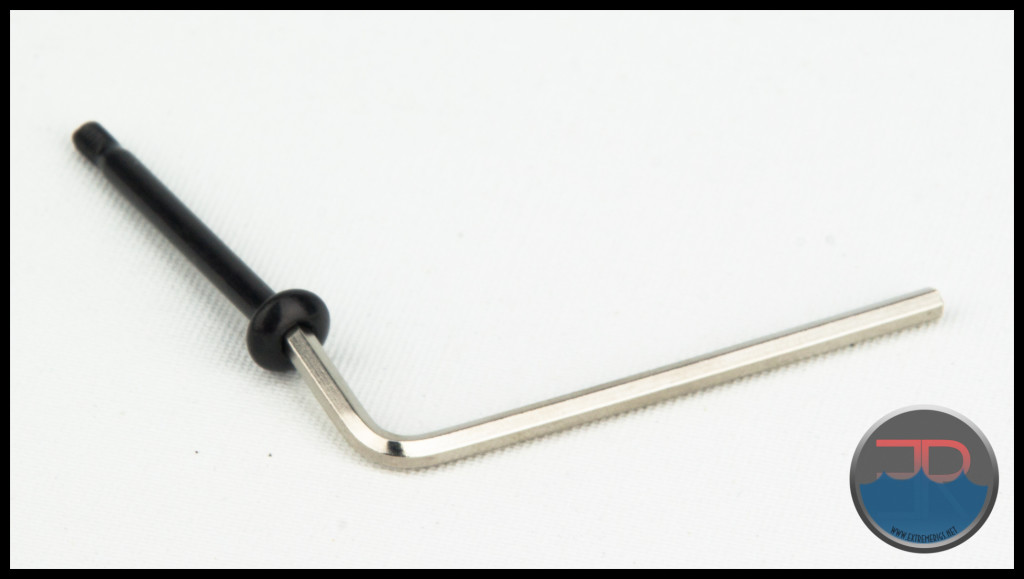
It is unusual that no warning about using correct screw length was on or in the packaging. however the following image is on the Alphacool website.
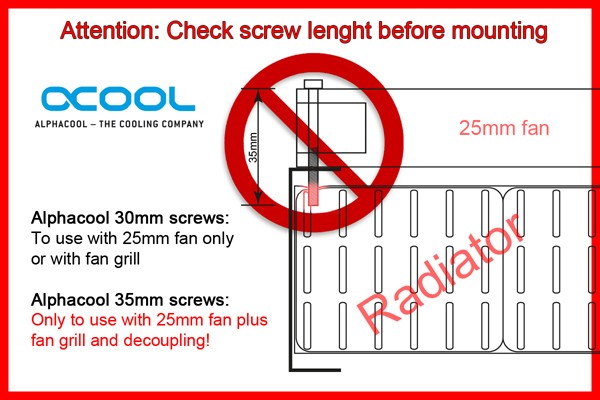 So we have been warned!
So we have been warned!
For Push/Pull fan assemblies without grills/gaskets, it is likely that you will need to source another set of 8 30mm length screws, or use the supplied 35mm screws with the less desirable and more ugly option of using washers to pack out behind the screw heads.
Onwards to technical specifications!
Technical Specifications
Technical Specifications as listed by Alphacool:
Material casing: Side panels steel, threads brass, copper chambers
Colour: Black
Dimensions (LxWxH): 319 x 144 x 30 mm
Connection threads: 2×1/4“
Mounting thread size: M3
Pressure tested: 1.5bar
Weight: 0,855kg”
The following is from the Aqua Tuning web-page for the ST30 280
It offers a few more details, However there does appear to be a discrepancy between the overall length stated between Alphacool and Aqua Tuning.
| Case: | Steel |
| Color: | black |
| Connector: | 2x G1/4 |
| Cooling channels: | Copper |
| Dimensions (L x B x H): | 297 x 144 x 30mm |
| Fan mounting thread: | M3 |
| Fan size: | 140mm |
| Fins per inch: | 16 |
| Manufacturer: | Alphacool |
| Material lamellae: | Copper |
| Number of fans: | 2 |
| Pressure tested: | 2 Bar |
| Thickness: | S – 30mm |
The following Technical Drawing of the ST30 280 which is courtesy of Alphacool offers an overall length of 317.5mm
Dimensions Measured on the Radiator Tested:
 The review sample measurements only differ by up to 0.5mm to the Technical Drawing sizes which is close enough for us.
The review sample measurements only differ by up to 0.5mm to the Technical Drawing sizes which is close enough for us.
The ST30 280 review sample measured in at 29.5mm thick and surely is the definition of a slim radiator. With it’s 140.x stables mates along side, the ST30’s thinness (rather than thickness) is much more obvious.
Radiator Core Dimensions:

The 16.5 mm thick core is made up of a single layer of 14 x 1.5mm copper tubes which are arranged in the standard U-Flow configuration. The fin arrangement consists of single serpentine fins which are louvered and has a 16 FPI count. This core figuration, on paper at least, appears to be tuned for low to medium speed fans. We’ll have to wait until our performance tests to find out if this turns out to be the case..
The following picture is a reference which shows a typical U-Flow coolant flow path, where the coolant travels up all the tubes on one side (left in pic) of the rad and then returns down the other side. U-Flow is most easily recognized when the port end has 2 separate tanks, such as those on the ST30 280.
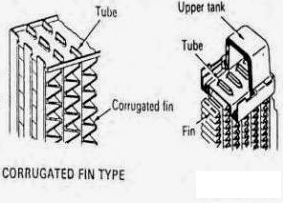
The louvered fins were spaced quite evenly between the tubes on the review sample, despite the following photo showing a fin count spread of 15 – 20 FPI.
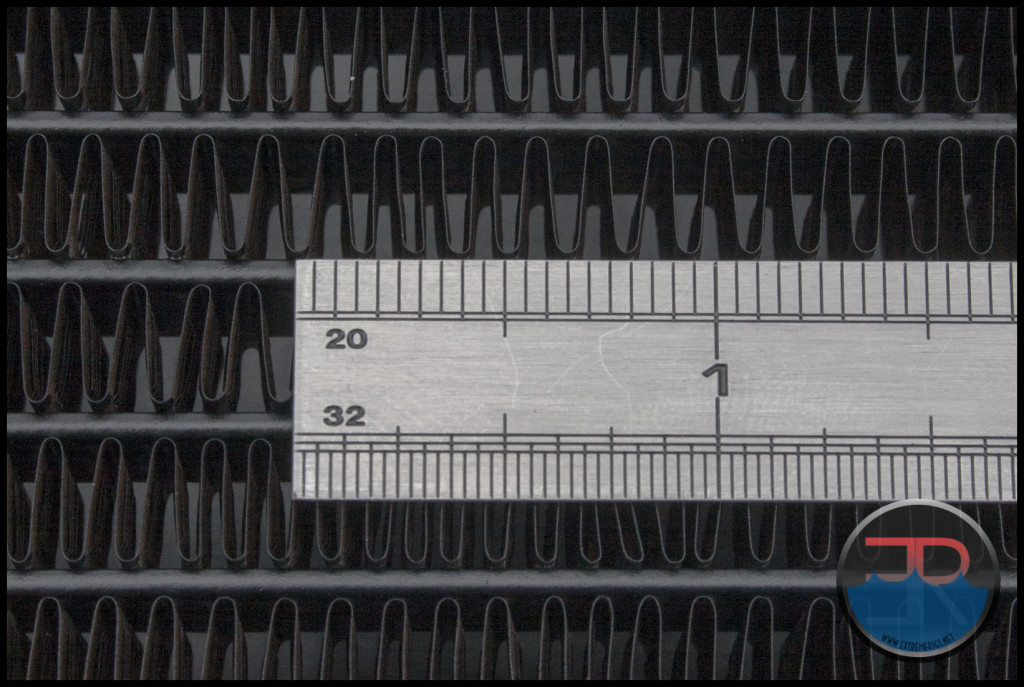
Finish and Features
The satin black paint finish on the ST30 280 is silky smooth and blemish free. This latest revision of Alphacool NexXxos radiators with the blue logos have a much better overall finish than previous versions.
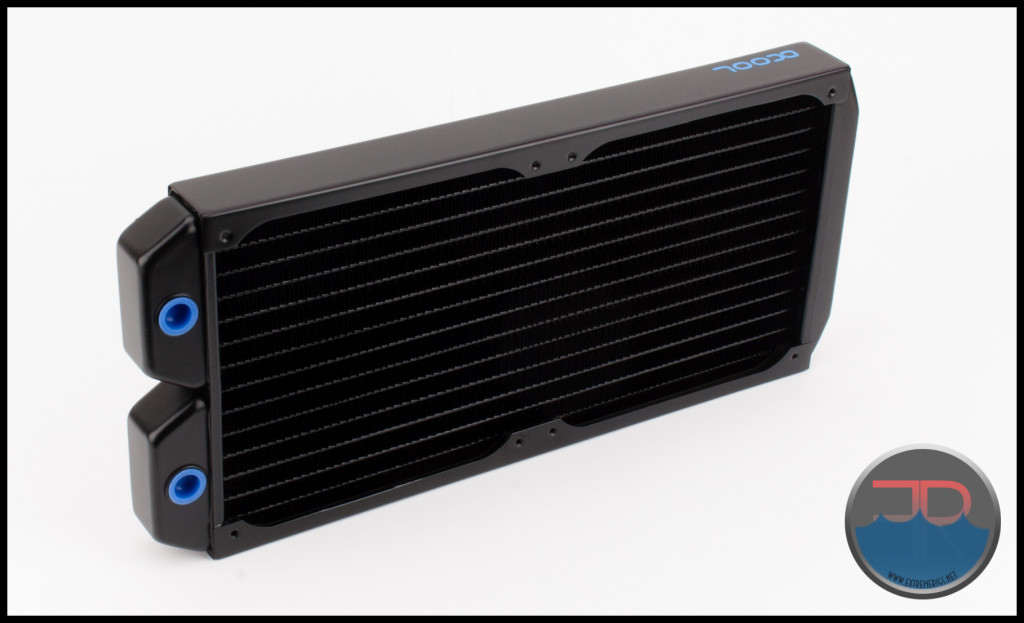
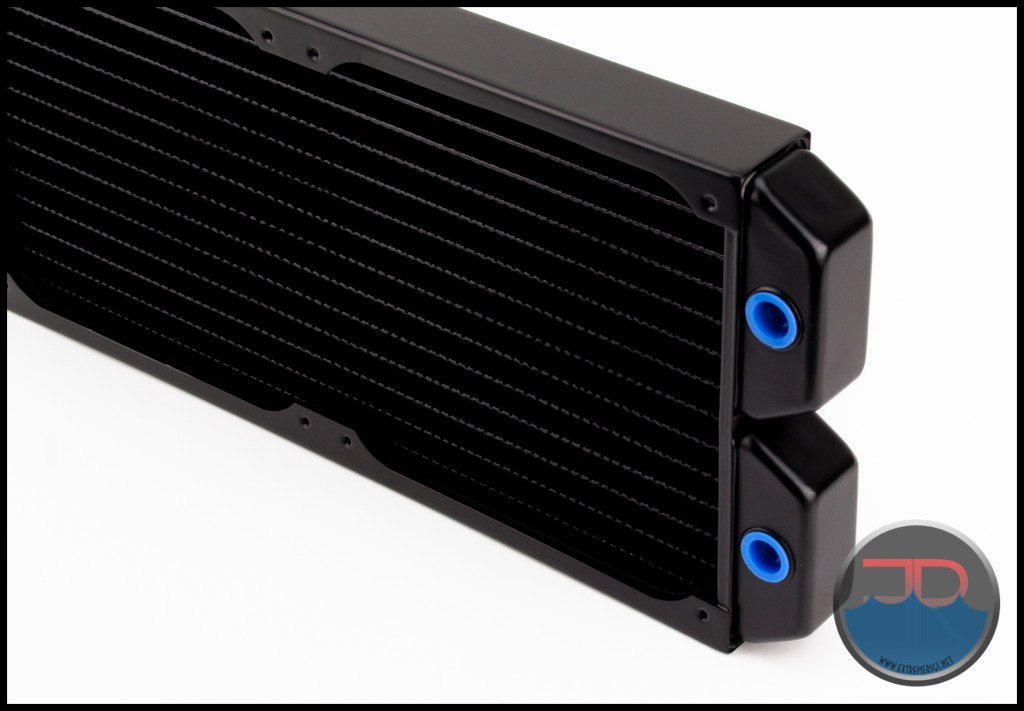
A small Alphacool logo is present on each side. The painted blue logo represents the latest (4th, maybe 5th) generation of the NexXxos series radiators. When floor mounted and the logo will be the right way up, but will be upside down when roof mounted.
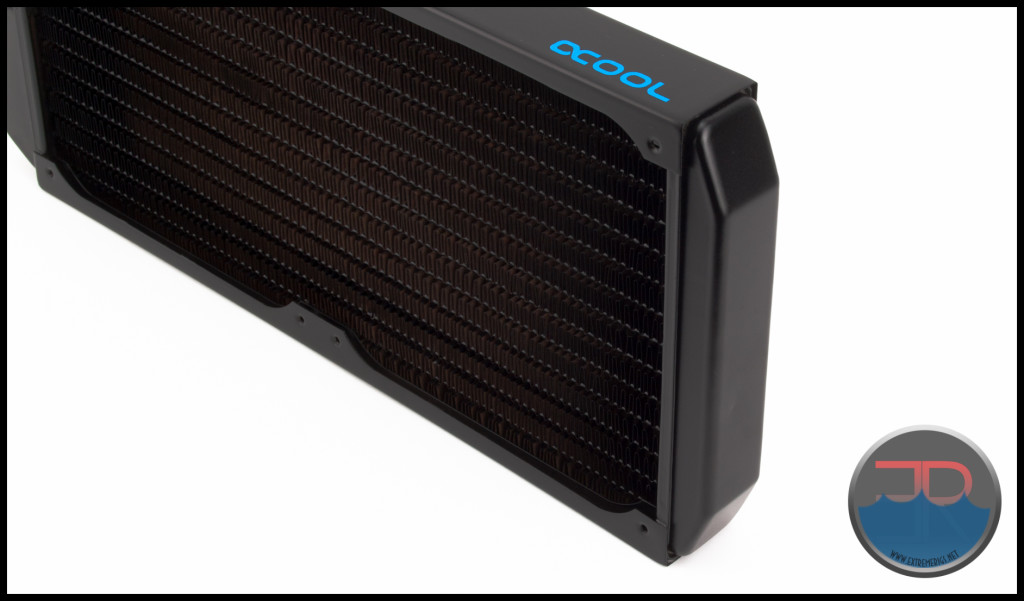 Screw protection plates are fitted under each fan attachment hole on the ST30 280.
Screw protection plates are fitted under each fan attachment hole on the ST30 280.
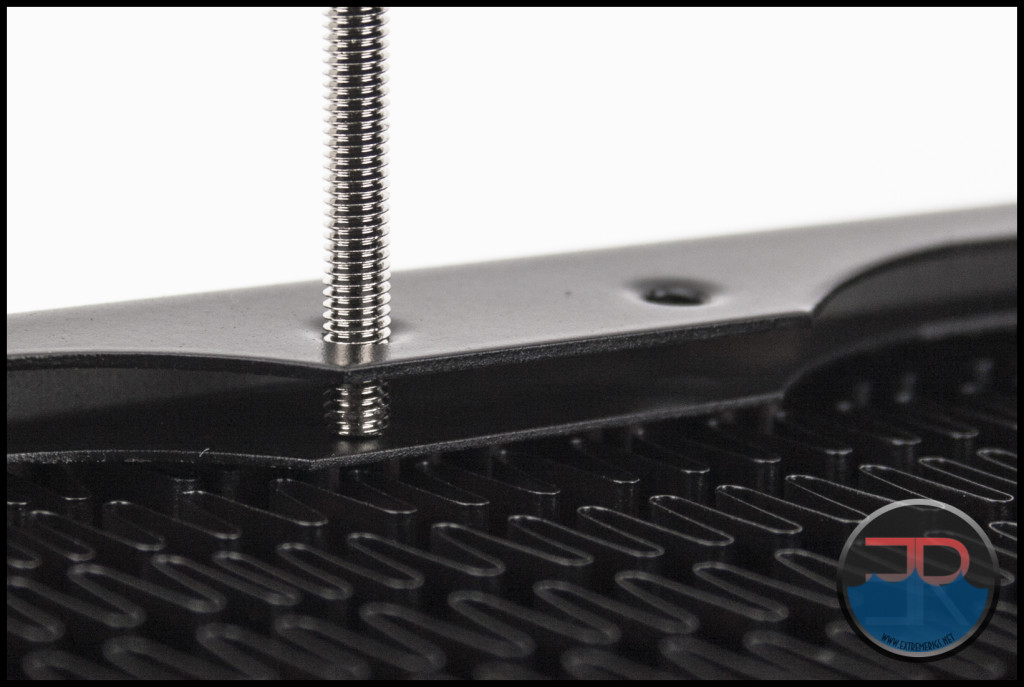 In these two photos silver colored screws were used to better show the screws on the protection plates.
In these two photos silver colored screws were used to better show the screws on the protection plates.
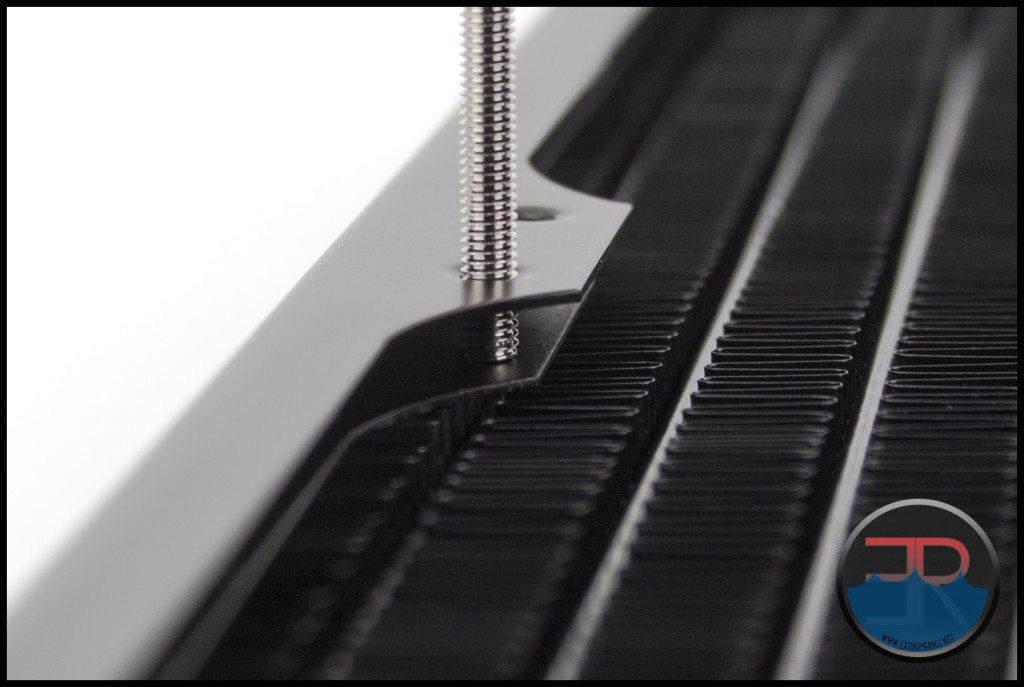 These protection plates will save the radiator from damage if custom length screws are used and are especially useful on the ST30 as the fan mounting holes are located directly above the tubes.
These protection plates will save the radiator from damage if custom length screws are used and are especially useful on the ST30 as the fan mounting holes are located directly above the tubes.
When using the supplied 30mm screws to attach a 25mm fan directly to the radiator, the screws just bottom out on the protect plate as the fan is firmly secured.
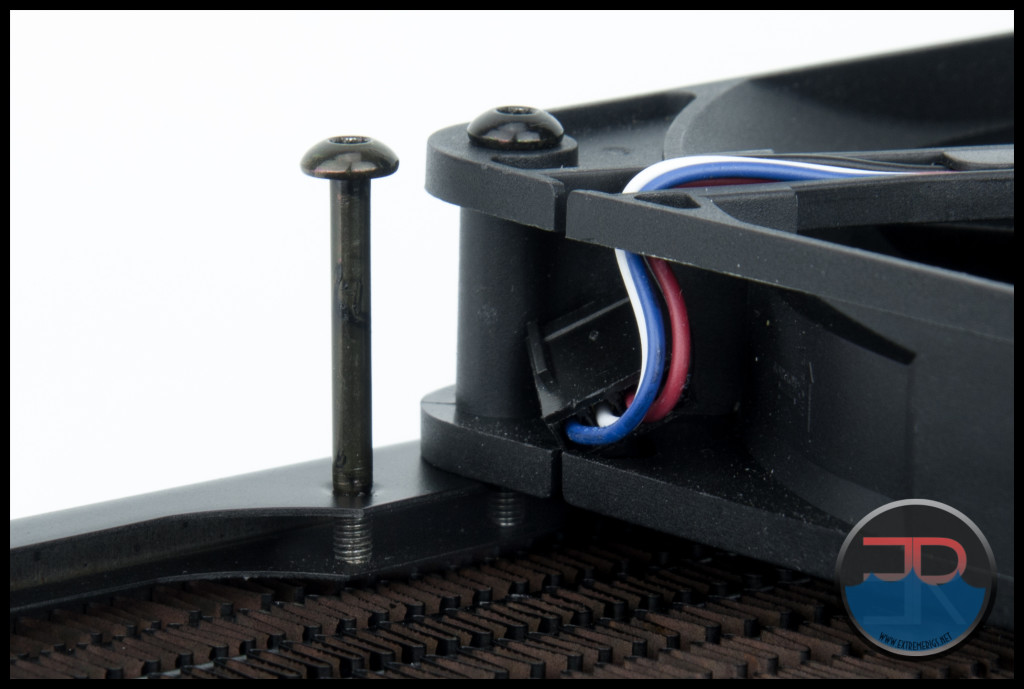 This is almost a perfect combination of screw length and plate depth. The 30mm length screws are the ideal length for direct attachment of a 25mm thick fan and for mounting the radiator with a fan onto a case panel.
This is almost a perfect combination of screw length and plate depth. The 30mm length screws are the ideal length for direct attachment of a 25mm thick fan and for mounting the radiator with a fan onto a case panel.
Below a 35mm screw is fitted beside the 30mm. This 35mm screw ran out of thread just before touching the protection plate. Without a grill and or gaskets and the case panel (or mounting bracket) to go through, these 35mm screws are too long to use, hence our suggestion earlier that for a Push/Pull set-up you will likely need to purchase addition set of 30mm length screws.
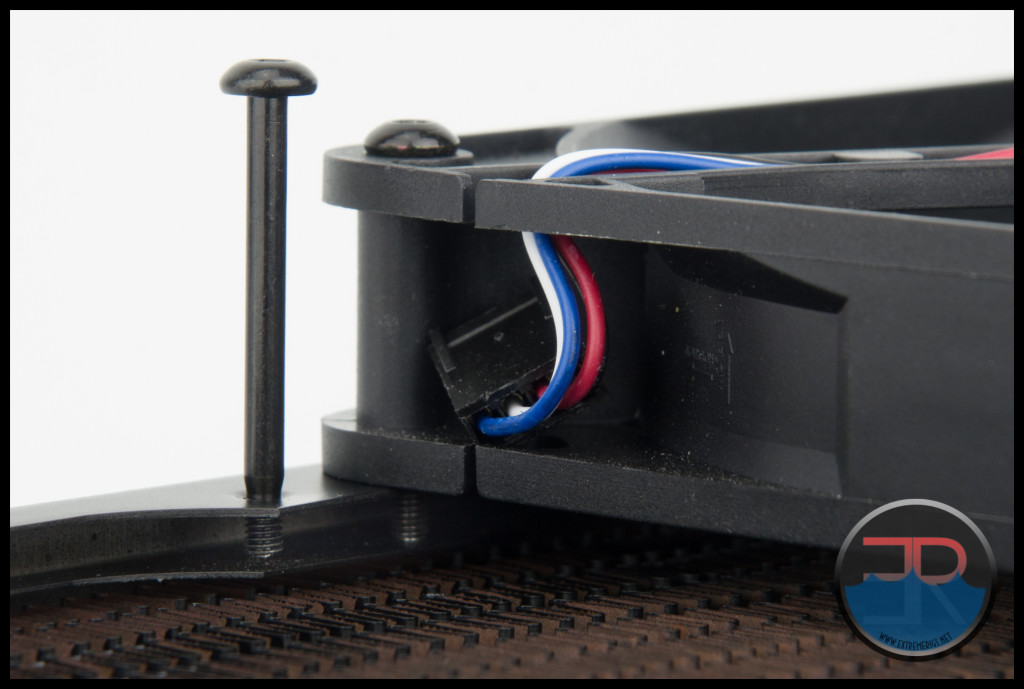
We have expressed our concern previously about Alphacool’s decision to use a 16mm spacing between the central fan attachment holes. The industry “standard” is 15 mm, and why they have chosen to use 16mm is still unknown. I have seen build logs where users have had to unnecessarily modify their cases to accommodate the screw locations on the 140.x Alphacool radiators.
We just looked at the spacing between fans and while that 16mm is bothersome, of more concern is the spacing for each fan: in particular the spacing across the width of the radiator.
I am unsure if there is an industry standard for the distance apart fan mounting holes should be, but I am certain that all the 140mm fans I have are made with a 125mm spacing.
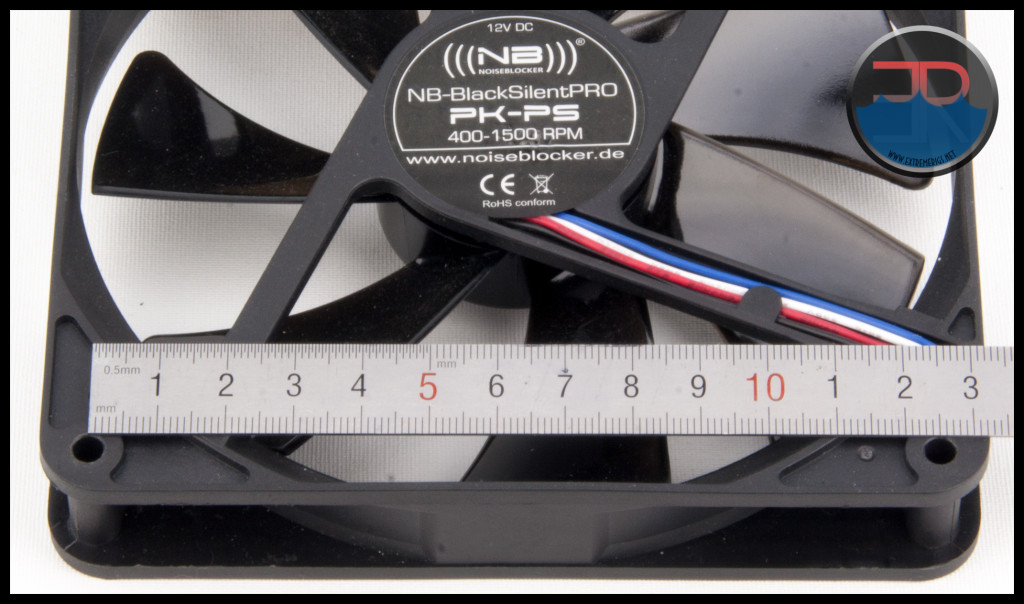
Below we see a ~124mm spacing at one end of the ST30 280. This is usable, but only just. Because the supplied screws have a thicker shank there is less wiggle room to adjust the fan’s position when starting off the threads. Therefore a tighter tolerance is needed in manufacturing for the threaded screw holes to match up with the mounting holes on a fan.
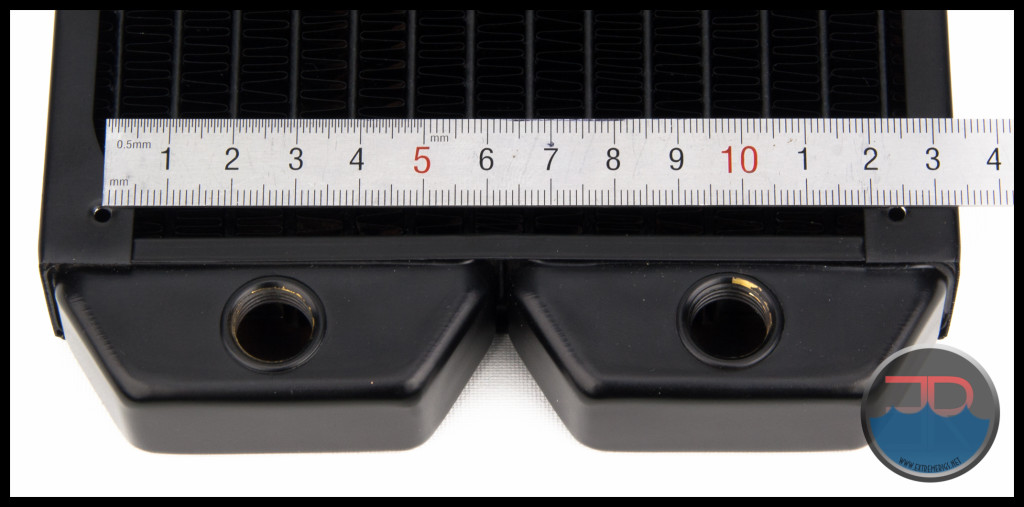 The spacing across the 2 center sets of holes was worse at ~122mm than at the ends.
The spacing across the 2 center sets of holes was worse at ~122mm than at the ends.
Due to this poor spacing I was not able to get all 4 screws in for each fan when mounting them onto the ST30.
This is unacceptable and quality control missed the mark big time on this one.
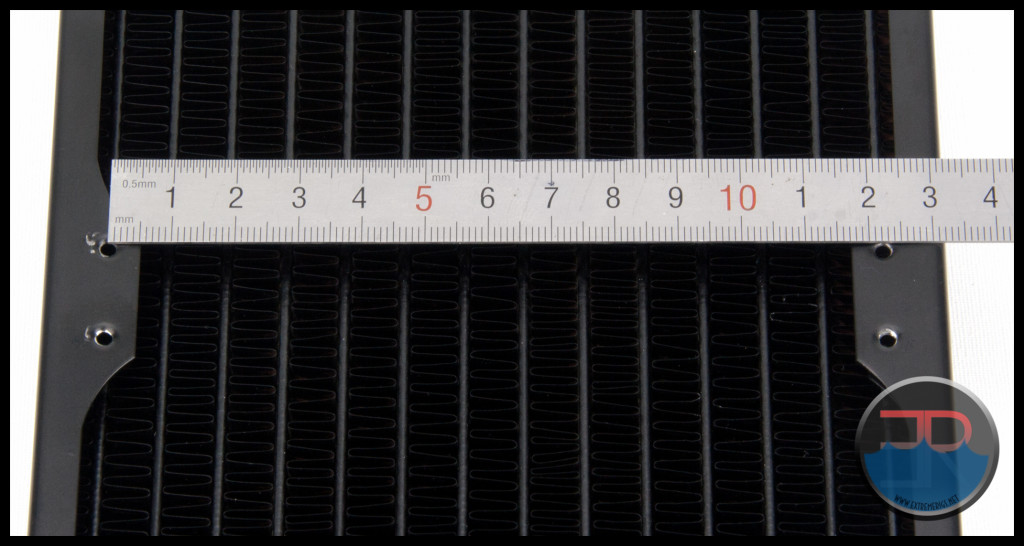 The “tell tales” of scratched paint around the screw holes are not just there from me fumbling around. The holes are not positioned anywhere near close enough to allow for trouble free fan installation.
The “tell tales” of scratched paint around the screw holes are not just there from me fumbling around. The holes are not positioned anywhere near close enough to allow for trouble free fan installation.
Having said that I did take some photos taken with fans attached, but only 3 screws per fan were able to be used.
In addition to the screw holes being incorrectly spaced, they are also not square to the radiator side panels as can seen on this first photo. (click to open full size in new tab)
Notice the the gap distance between the fans and then also use the top edge of the casing as a straight reference to give an indication of what I mean by the fan mounting holes not being square.
The ST30 280mm is fitted with just 2 G 1/4 ports.
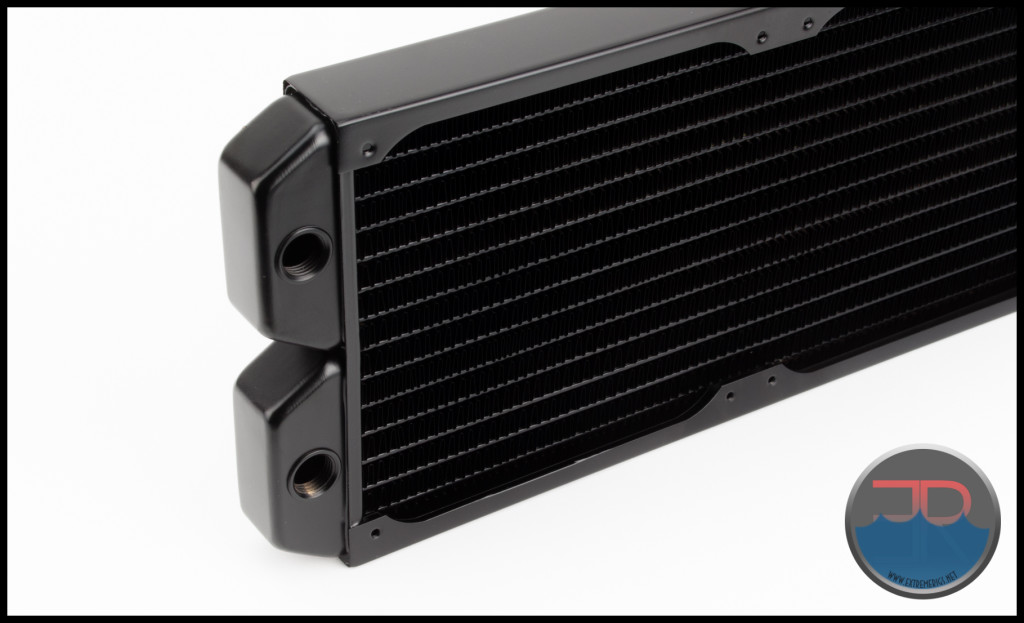 No alternate ports are on the other side or ends of the tanks.
No alternate ports are on the other side or ends of the tanks.
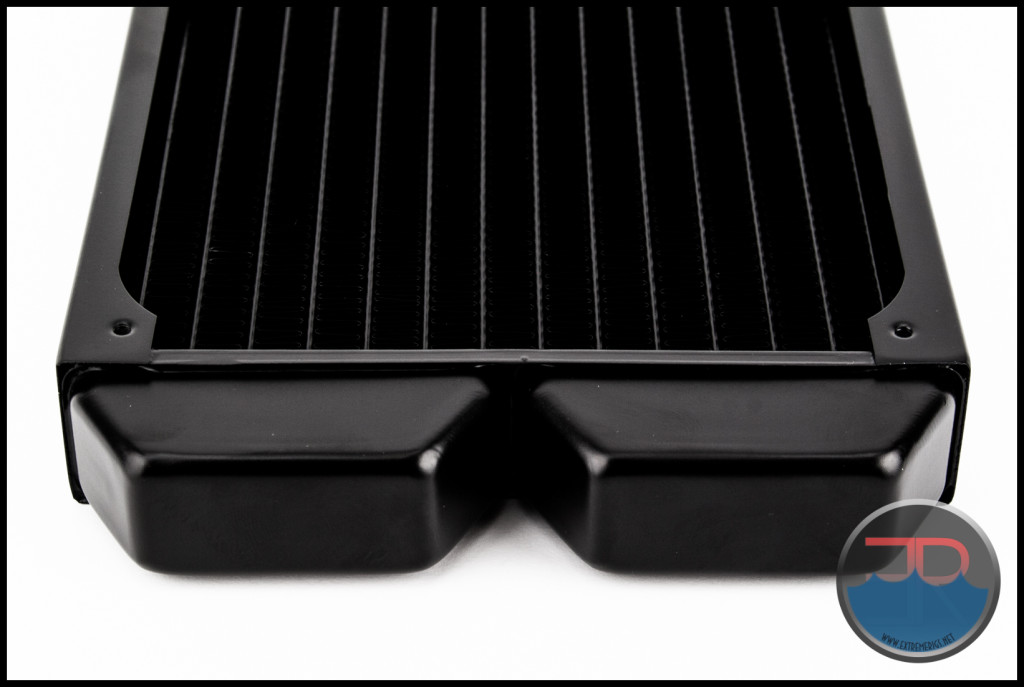 and no ancillary port is fitted to the return end.
and no ancillary port is fitted to the return end.
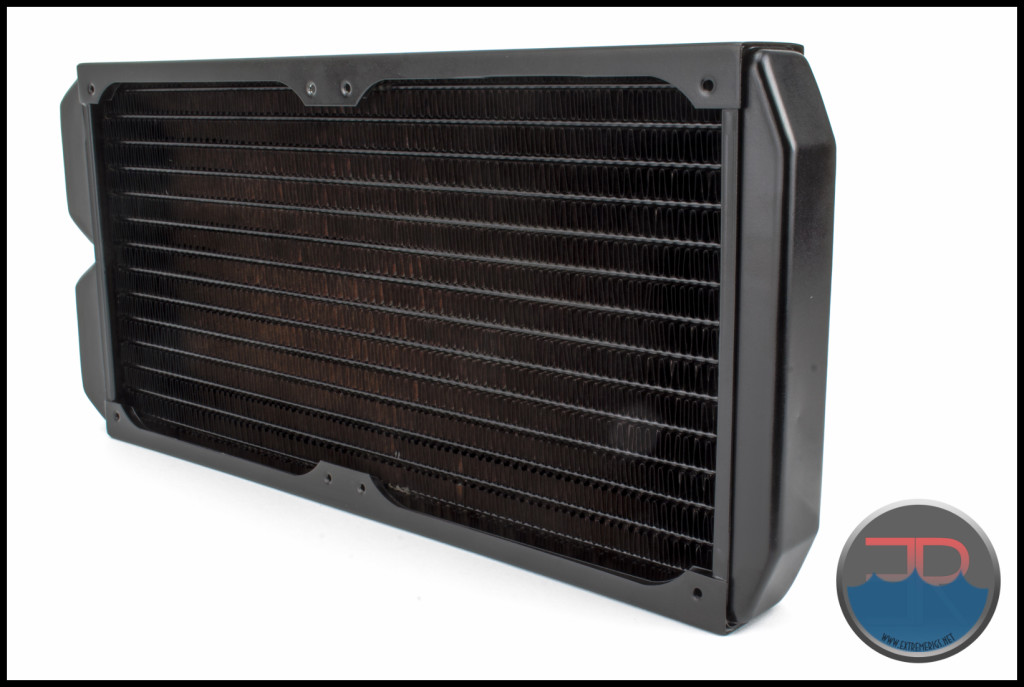 This leaves us with one very “traditional” option for installing the inlet and outlet fittings, and no option of a fill/bleed ports, or drain taps and temp sensors with additional fittings being used.
This leaves us with one very “traditional” option for installing the inlet and outlet fittings, and no option of a fill/bleed ports, or drain taps and temp sensors with additional fittings being used.
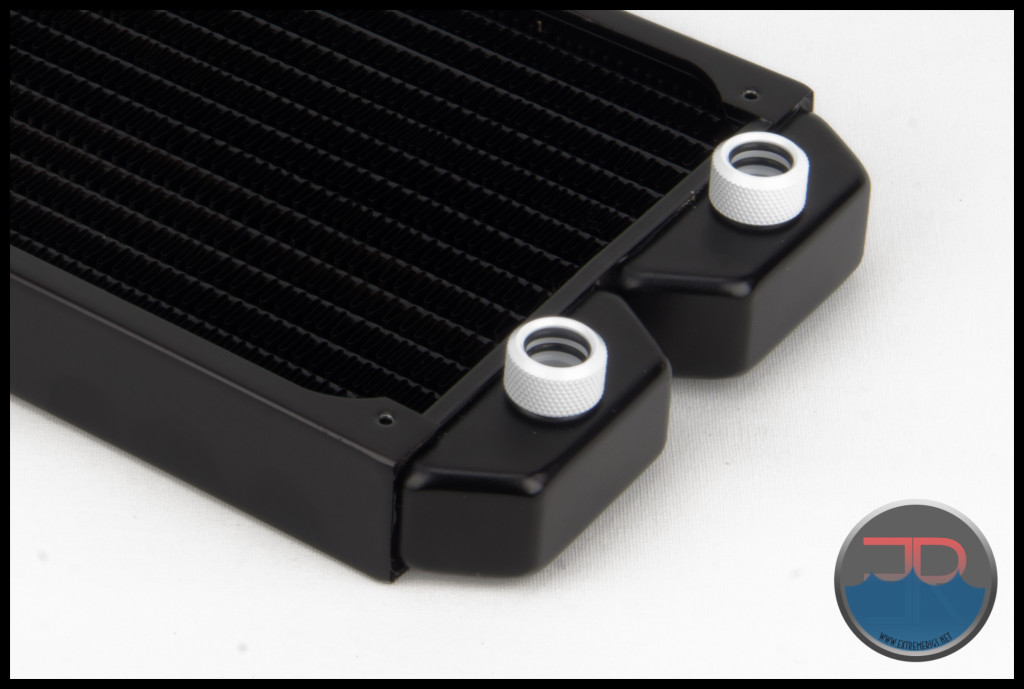 The current NexXxos range including the ST30 280mm have the threads of the G 1/4 ports painted black.
The current NexXxos range including the ST30 280mm have the threads of the G 1/4 ports painted black.
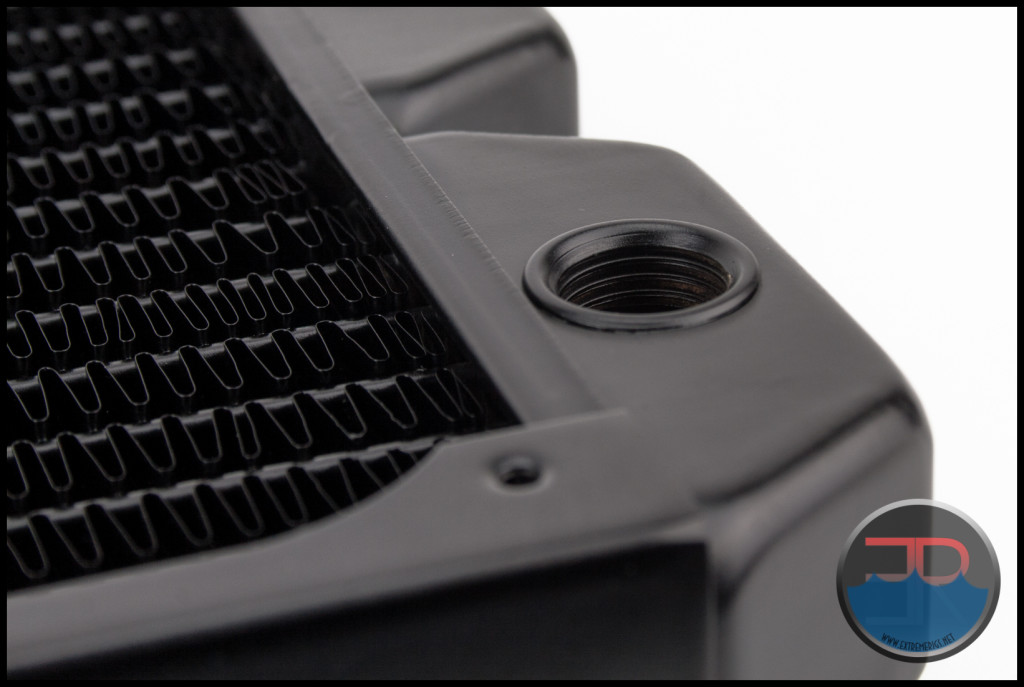
It is unavoidable that paint will chip away or get scraped off when screwing fittings into the threads and where will these paint chips end up? The most likely answer is in the micro channels of your block, possibly reducing the flow rate and overall performance of the system.
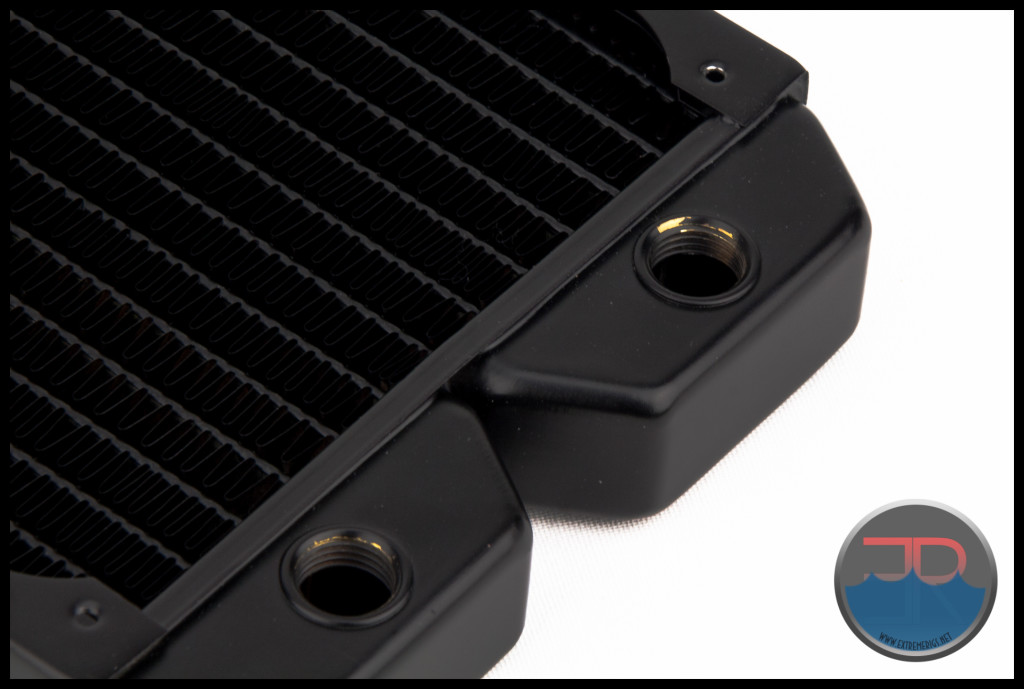
Another issue which we encountered is that the inlet and outlet tanks of the ST30 are very short, or more specifically the the G 1/4 ports are positioned very close to the end of the core (as seen in the above photo).
This means that many fittings are not be able to be used when fans are attached on the port side of the radiator.
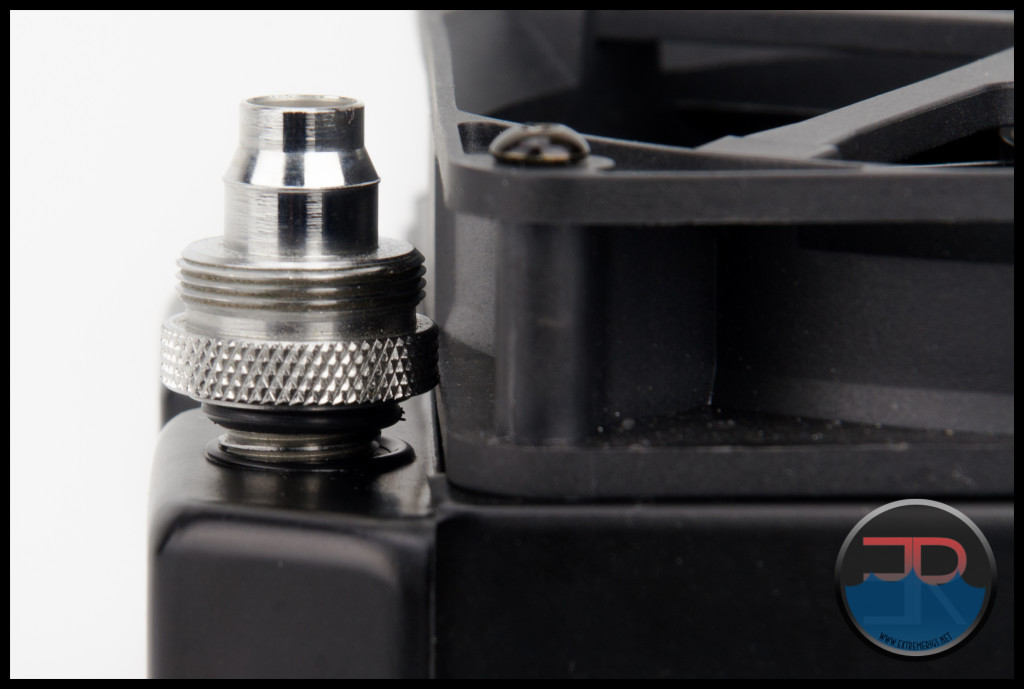 Above we see that the base of a Bitspower 3/8 x 5/8 compression fitting was not able to be screwed in when a fan was already installed. This is a very commonly used fitting with dimensions similar to many other fittings on the market. To not be able to fit a common medium sized fitting seems like an oversight in the design process. There is no chance therefore of using any 3/4″ OD fittings.
Above we see that the base of a Bitspower 3/8 x 5/8 compression fitting was not able to be screwed in when a fan was already installed. This is a very commonly used fitting with dimensions similar to many other fittings on the market. To not be able to fit a common medium sized fitting seems like an oversight in the design process. There is no chance therefore of using any 3/4″ OD fittings.
In the following photo we see one of Alphacool’s own HD series hard tube fitting has no chance of screwing down. The base fits, but the collar hangs up on the fan frame.
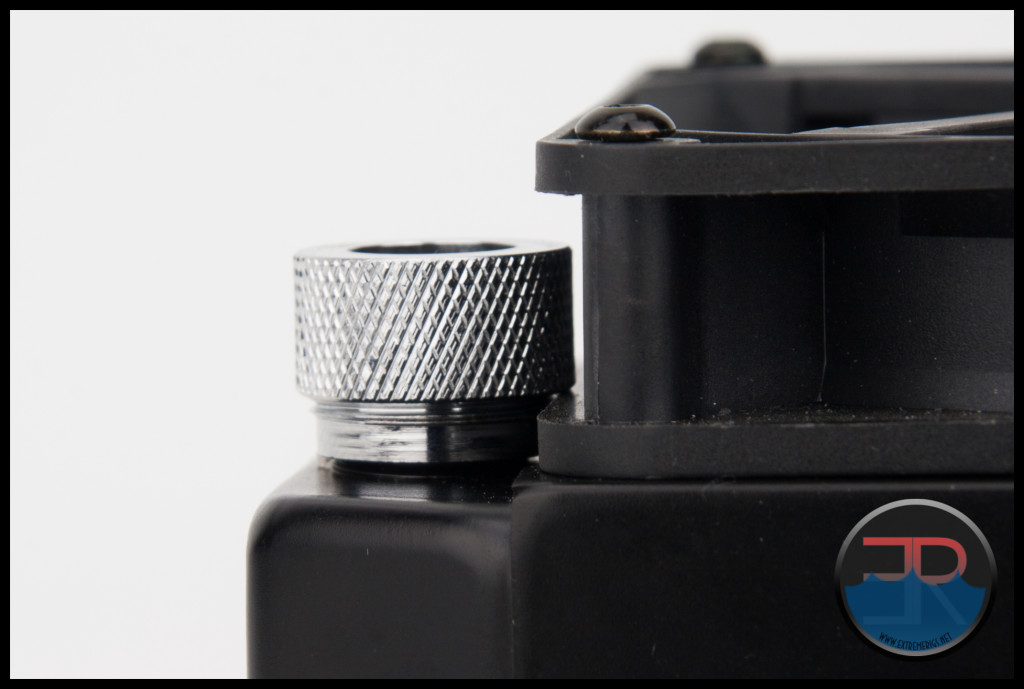 Here is the same fitting with the fan removed to show the the overhang of the collar. With fans installed on the other side this just works. The collar tightens down pretty firm (with a tube installed) just before it bottoms out on the frame.
Here is the same fitting with the fan removed to show the the overhang of the collar. With fans installed on the other side this just works. The collar tightens down pretty firm (with a tube installed) just before it bottoms out on the frame.
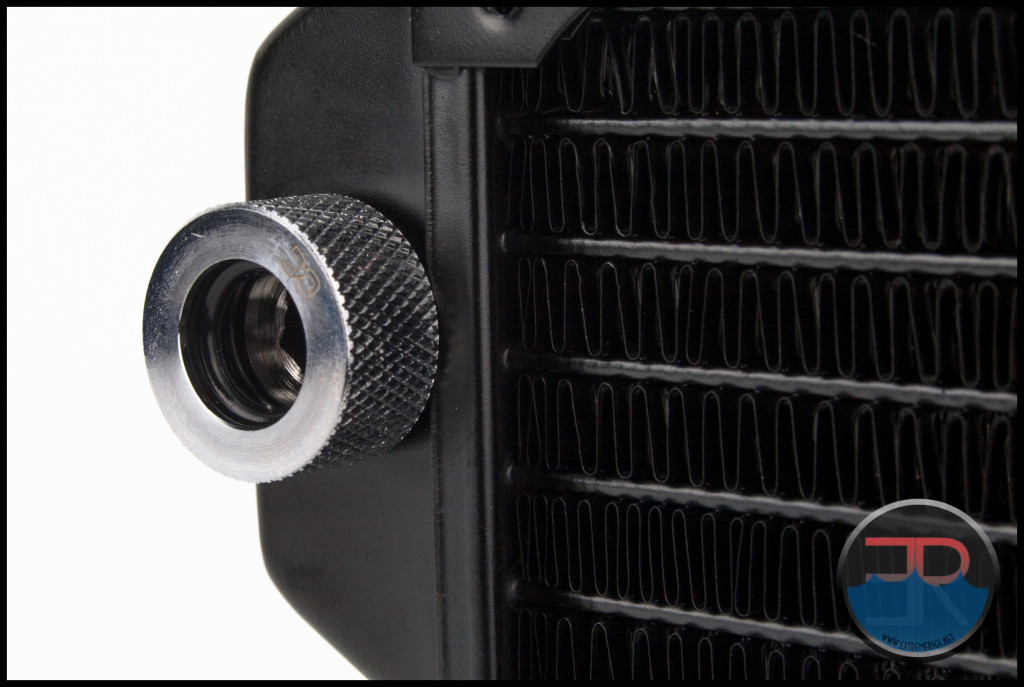
I found that the maximum width a fitting can be with fans attached on the port side is 19.25mm
Internal Cleanliness:
On a more positive note, the latest revision of NexXxos radiators (with blue logos) are coming out with a different cleaning process after manufacturing. This new process has resulted in unexpected and surprisingly clean internals. I recently flushed/cleaned 5 different current version Alphacool radiators including the ST 280 reviewed here, and all were within reasonable expectations of being clean and free of excess amount of debris after the first rinse.
We still strongly advise cleaning all new radiators prior to use, but it is great to see that what was a terrible problem has now been rectified.
So here we have a slim ~30mm thick radiator with a low to medium density core. It has just 2 ports which unfortunately have been installed so close to the core that many fittings can not be used when fans are installed on the port side. Screw protection plates are fitted but the screw attachment holes are out of alignment so only 3 of the 4 screws for each fan could be fitted. The paint finish on the sample was excellent but we feel that the paint on the inside of the ports could lead to unwanted problems.
Let’s see how it performs…
Flow Rate Testing
The Data
As all the testing was performed with the exact same equipment (except the 140mm Noctua Industrial fans replace the 120mm GT fans), using the exact same methods as was used in the 360mm round-up, we have decided to keep this review uncluttered by keeping our testing methodology, test set-ups and equipment used in a single location. To see exactly how the tests were carried out, details of the test set ups and equipment used, please head over to the RRU Test Setup page.
Restriction Test
It is generally agreed that radiators are one of, if not the least restrictive components in a water cooling loop. There are some exceptions however, so this must still be verified through testing:
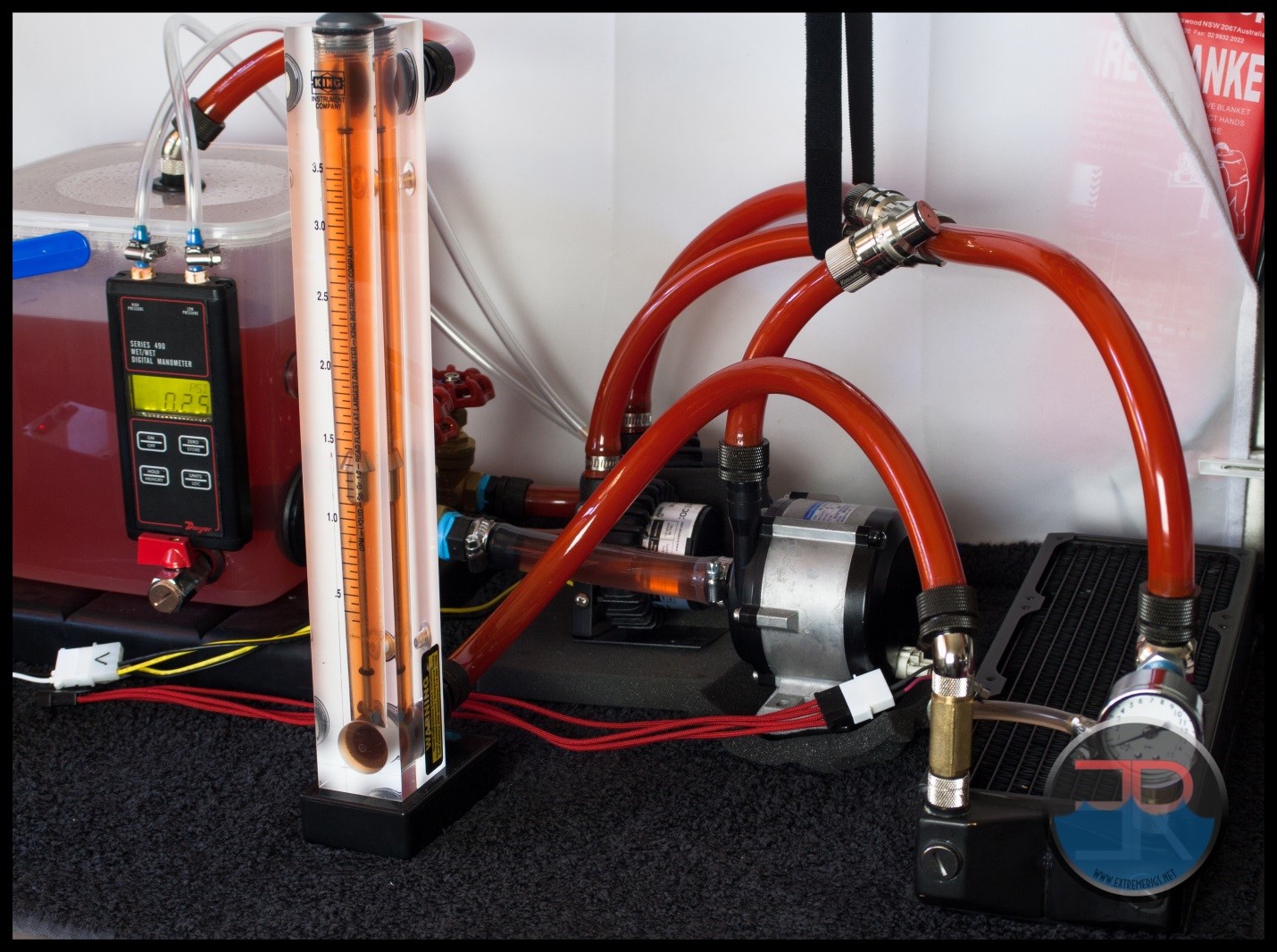 The above photo is for referencing the restriction test bench The ST30 is not loaded so please disregard the readings in the picture as it does not relate to the its test results.
The above photo is for referencing the restriction test bench The ST30 is not loaded so please disregard the readings in the picture as it does not relate to the its test results.
Here is the raw data at the tested flow rates, displaying the measured Differential Pressure across the radiator as flow rate was increased.
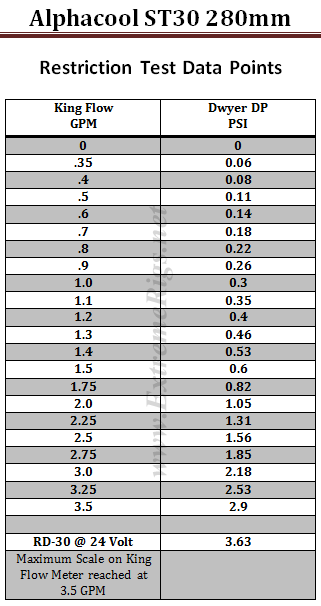 The table numbers indicate that this ST30 280 is a medium restriction radiator. However numbers in isolation can only tell half the story. By plotting against other components it more easily shows the whole story.
The table numbers indicate that this ST30 280 is a medium restriction radiator. However numbers in isolation can only tell half the story. By plotting against other components it more easily shows the whole story.
We use a HeatKiller 3.0 CPU block as the reference in this next plot for two reasons. Firstly there is little chance of the plot being cluttered by curves overlapping and secondly it gives a reference point against a fairly common loop component of average restriction.
As with all previous radiator restriction plots, we have limited the maximum flow rate displayed to 2.0 GPM as we suspect there are very few systems that operate above 2.0 GPM. For more information on how to read a restriction plot check out our guide.
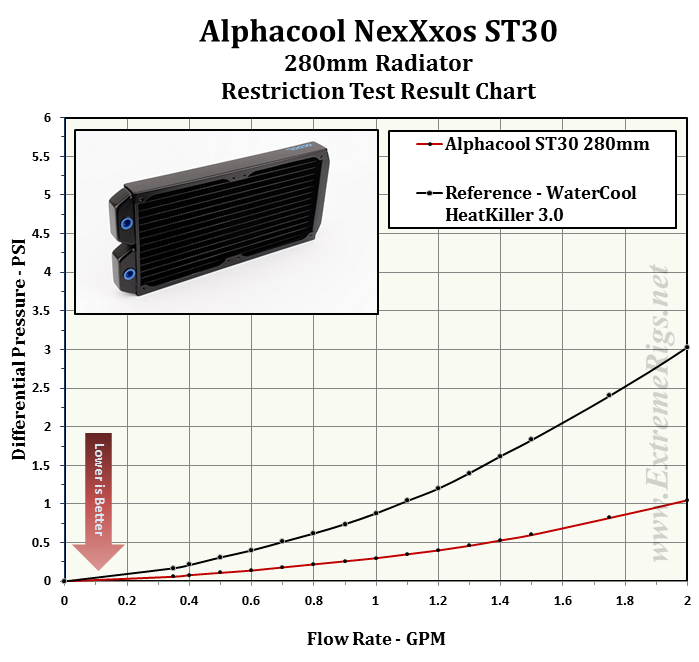 This plot indicates the ST30 280 is a low restriction loop component when compared to a CPU block of average restriction, but what about other radiators?
This plot indicates the ST30 280 is a low restriction loop component when compared to a CPU block of average restriction, but what about other radiators?
The next three plots show the restriction level at three different flow rates compared to the other 280mm radiator that have been tested. We consider the chosen GPM rates to represent systems which have low, medium and high flow rates.
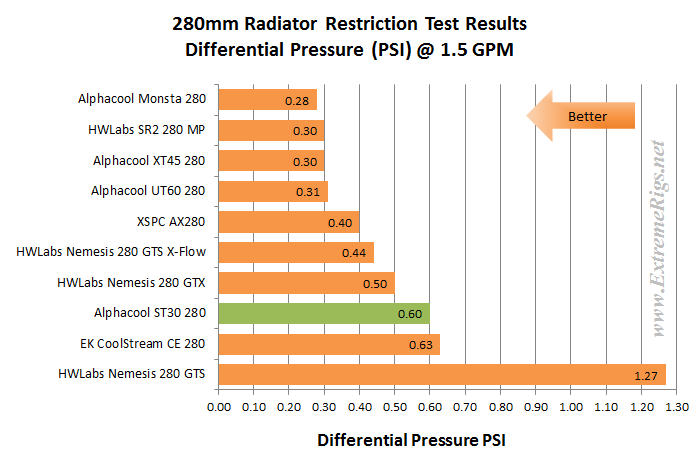
While the ST30 280 is one of the higher restriction radiators in the 280mm test group, we certainly don’t rate it as being high. It just reinforces our earlier statement that radiators are in general low restriction loop components.
In the following plot the data has been zoomed in to display only between 0.8 GPM and 1.2 GPM which is what an average system’s flow rate would be running at. Clearly there is not a lot of variance between the least restrictive radiators of the group.
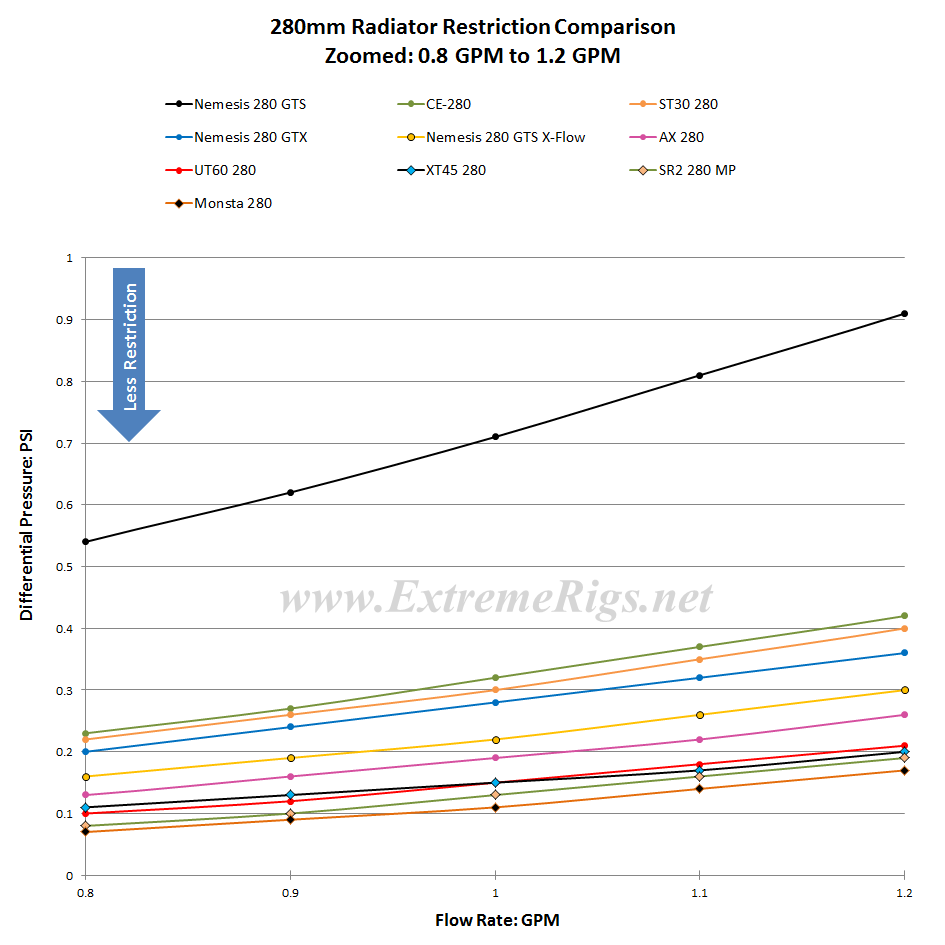 Let’s now take a look at where the ST30 fits in relation to all the radiators we have tested. For this plot, only results for 1.0 GPM have been used for the comparison.
Let’s now take a look at where the ST30 fits in relation to all the radiators we have tested. For this plot, only results for 1.0 GPM have been used for the comparison.
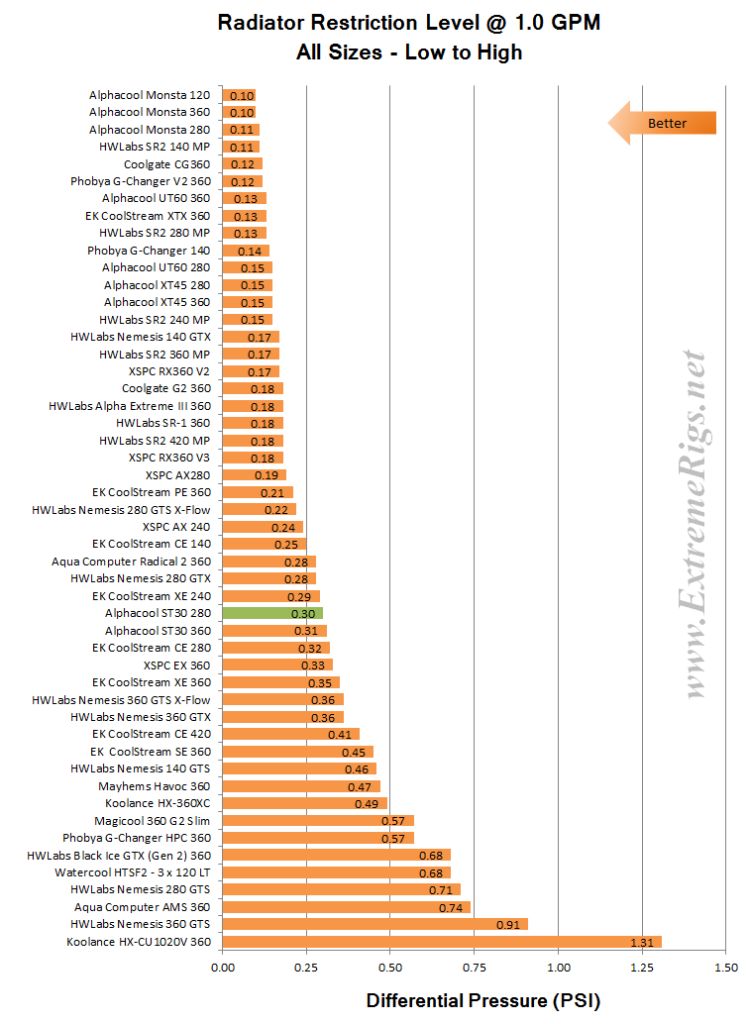 When put into context with all the radiators at 1.0 GPM, the ST30 280 fits into our criteria as a medium restriction radiator. This means you could comfortable run 2 or 3 ST30 series radiators without having to be concerned about them reducing your flow rate by too much.
When put into context with all the radiators at 1.0 GPM, the ST30 280 fits into our criteria as a medium restriction radiator. This means you could comfortable run 2 or 3 ST30 series radiators without having to be concerned about them reducing your flow rate by too much.
Excellent!!
Next onwards to Thermal Performance.
Thermal Testing
The Thermal Data
A total of 6 tests were conducted at 1.0 GPM with fan speeds of 750 rpm, 1300 rpm and 1850 rpm being run in ‘Push Only’ and ‘Push/Pull’. All inclusive this testing takes between 40 – 50 hours of logging time (plus processing the data) to get the results that are presented.
Below is the final data results gathered from at least 5 data logging runs at the flow rate and fan rpm combination. The most stable 15 minute period from each logging run was used and then averaged with the other runs to obtain the data for the table below. A total of 16 temperature sensors are used in the thermal test chamber (8 air in, 2 air out, 3 water in, 3 water out). Each sensor takes a reading every second and is logged via a CrystalFontz unit.
The data in the table below is the averaged results of the logging runs which has then been used to create all the plots and tables there-after.
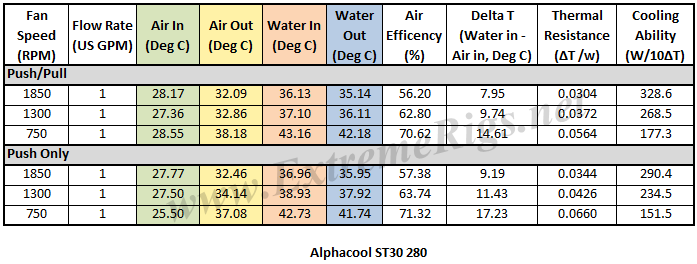 The performance metric of critical importance is the delta between the warm coolant temperature in and the cool ambient air temperature going into the radiator. Given that the system is well insulated and in equilibrium and we know the heat input to the system then we can also calculate a very important number. That number is the amount of power required to raise the coolant temperature by set amount. That amount is typically 1C or 10C. The latter is a more useful reference point.
The performance metric of critical importance is the delta between the warm coolant temperature in and the cool ambient air temperature going into the radiator. Given that the system is well insulated and in equilibrium and we know the heat input to the system then we can also calculate a very important number. That number is the amount of power required to raise the coolant temperature by set amount. That amount is typically 1C or 10C. The latter is a more useful reference point.
Let’s take a look at the Delta T results from the tests. Note that the extrapolation of the curve is much more sensitive to error than in the tested range.
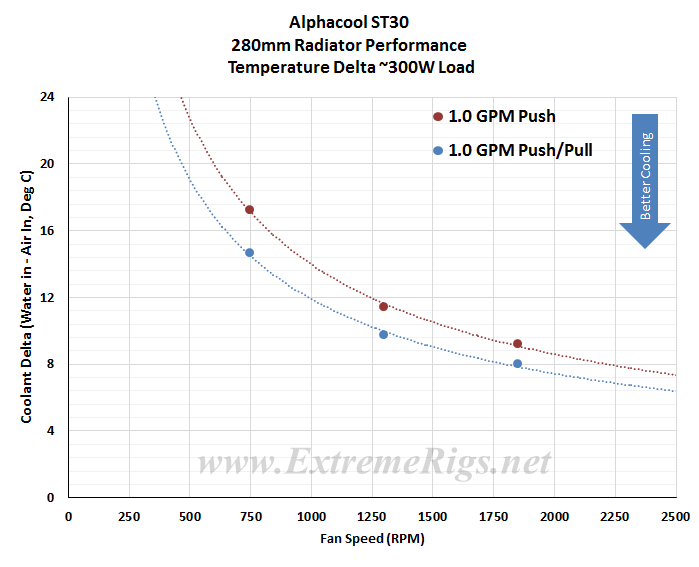 I was not too concerned about the actual delta numbers but instead the trend pattern. As we should expect, the deltas come down as the fan speed is increased. The less significant temperature drop from 1300 to 1850 rpm indicates the bulk of the radiators performance potential can be achieved with medium fan speeds.
I was not too concerned about the actual delta numbers but instead the trend pattern. As we should expect, the deltas come down as the fan speed is increased. The less significant temperature drop from 1300 to 1850 rpm indicates the bulk of the radiators performance potential can be achieved with medium fan speeds.
Delta T results (as above) are not always helpful when thinking about how many radiators you would need to cool your system. Instead it’s more useful to know the metric of W/Delta C. This metric is plotted below. It tells us how many Watts are dissipated by the radiator when the coolant rises 10C above ambient temperatures. (W/10 Delta T):
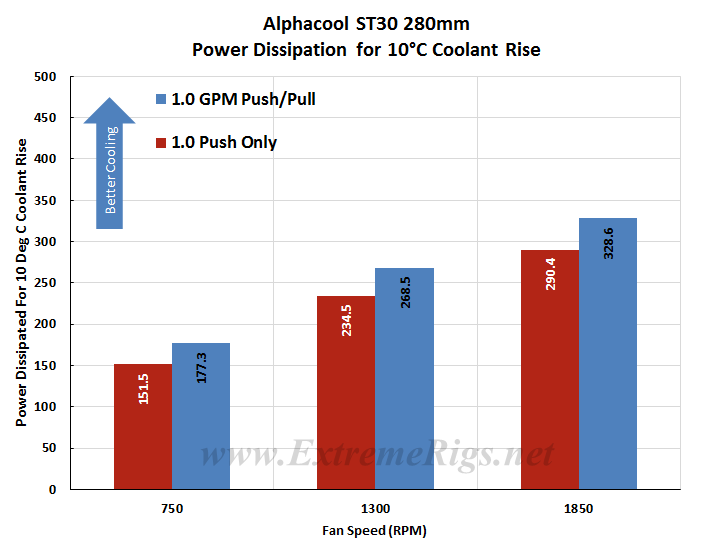 The average difference between Push Only and Push/Pull results at the same fan speed was ~13% which is the lowest of the test group. This means increasing fan speeds on the ST30 had less benefit than doing so on the other 280mm radiators of the group. Variance ranged from ~11.5% at 750 rpm to 14.5% at 1850 rpm. This reasonably close percentage difference shows that the ST30 280’s potential performance scales evenly across different fan assemblies as the fan speeds were increased.
The average difference between Push Only and Push/Pull results at the same fan speed was ~13% which is the lowest of the test group. This means increasing fan speeds on the ST30 had less benefit than doing so on the other 280mm radiators of the group. Variance ranged from ~11.5% at 750 rpm to 14.5% at 1850 rpm. This reasonably close percentage difference shows that the ST30 280’s potential performance scales evenly across different fan assemblies as the fan speeds were increased.
This same data can now be plotted on a chart so that an end user can interpolate their own fan speed. Note again that the extrapolation of the curve is much more sensitive to error than in between the tested range.
This extrapolation hints that the ST30 with it’s slim core is very close to approaching it’s maximum cooling under our tested conditions.
Now let’s analyze that data some more…
Data Analysis
This first table shows the ST30 280’s Watts/10 Delta Temp numbers in a quick glance chart format.

Using this data we can effectively show percentage gains/losses relative to a reference point. It’s an interesting way to show gains/losses while changing a variable.
So, let’s focus on 1300 RPM as our reference and see how much gain or loss in performance we get by changing fan speed.

From these results we see a ~35% drop in performance of from 1300rpm to 750 in both Push Only and Push/Pull. The modest increase of ~23% with the next fan speed increase is similar to those gained by the other slim radiators of the test group. This indicates the ST30 280 is likely best tuned for medium speed fans. This makes sense when we consider it’s thickness, the extra air volume of higher rpm fans are not as much benefit as it is on radiators with thicker cores.
So from the data above we’re getting a good idea of how the ST30 280 radiator performs relative to itself. But there is a large selection of 280mm radiator models to choose from, so let’s put the ST30’s results into some comparison charts.
Push Only Data vs Competition
In general, thicker radiator perform better than thinner radiators of the same size (fan capacity) but a lot also has to do with how each core has been designed / tuned; number of tubes, thickness of tubes, fin array etc.
So with that in mind, we should try to stay focused on the slim radiators which are the direct competition of the ST30, those being the 2 GTS variants by HWLabs and possibly even the AX 280 from XSPC which is 10mm thicker.
Focusing on the Push Only results for now, let’s see how the ST30 280’s performance compares to the competition.
Let’s start with 750 RPM.
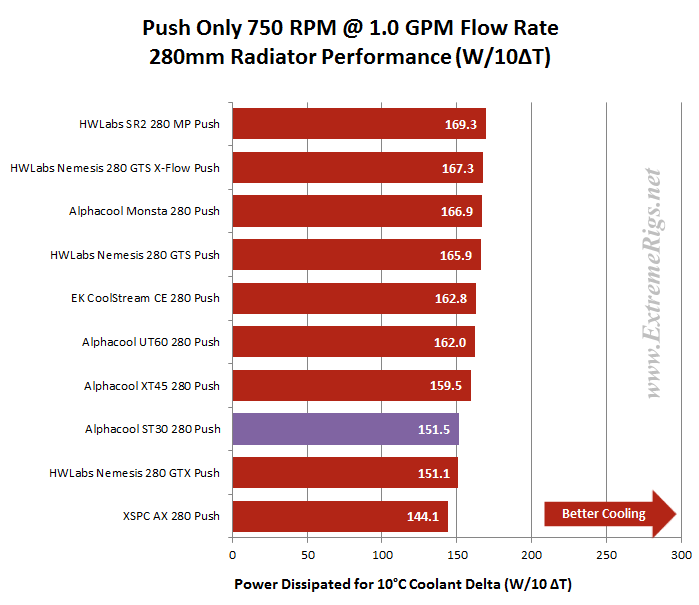 Clearly the ST30 280 has placed in the lower half of the results at Push Only at 750 RPM. With ~10% difference between it’s result and the best performing slim radiator in the lowest air test, let’s hope things improve when we add more air flow.
Clearly the ST30 280 has placed in the lower half of the results at Push Only at 750 RPM. With ~10% difference between it’s result and the best performing slim radiator in the lowest air test, let’s hope things improve when we add more air flow.
Now let’s look at 1300 rpm:
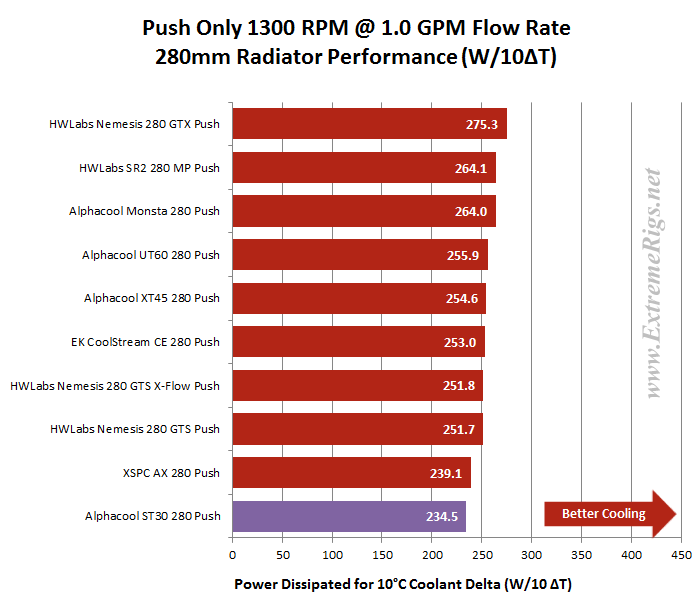 At Push Only 1300 RPM the ST30 280 finished in last place but gained ground on the other slim radiators, now being ~7% behind the best of them,.
At Push Only 1300 RPM the ST30 280 finished in last place but gained ground on the other slim radiators, now being ~7% behind the best of them,.
Now 1850 rpm Push Only:
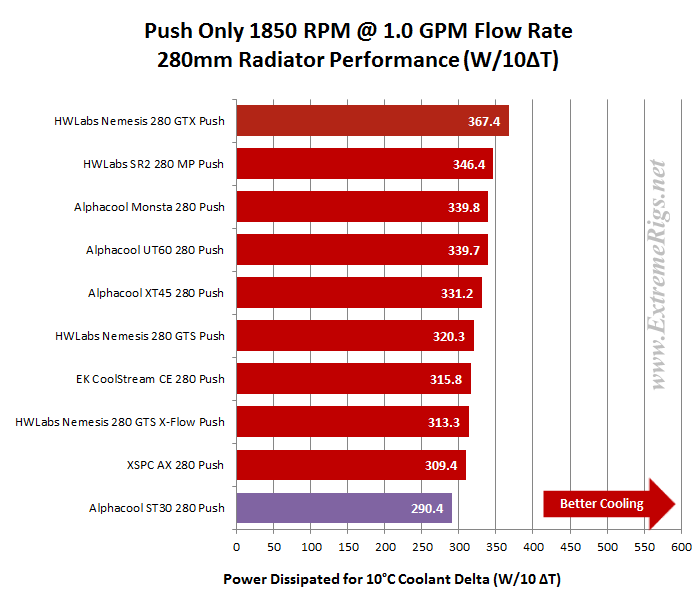 At 1850 rpm the ST30 280 again finishes in last position overall and has dropped a few percent to now be ~9.5% behind the best of the slims.
At 1850 rpm the ST30 280 again finishes in last position overall and has dropped a few percent to now be ~9.5% behind the best of the slims.
Let’s find out how the ST30 280 performs with Push/Pull fans.
Push/Pull Data vs. Competition
Firstly the 750 rpm:
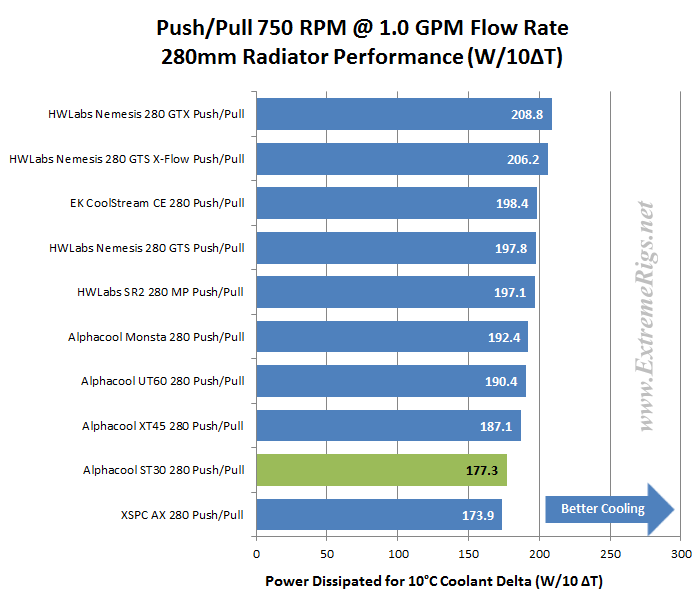 The ST30 280 is again near the bottom of the group at this data point, ~14% behind the best of the slim radiators
The ST30 280 is again near the bottom of the group at this data point, ~14% behind the best of the slim radiators
Let’s move to 1300 rpm:
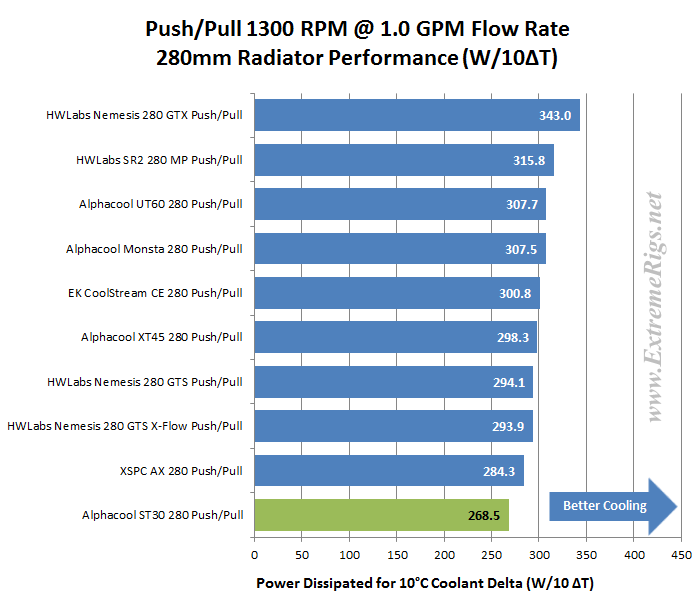 The ST30 find itself in a familiar position, again at the bottom of the results table.
The ST30 find itself in a familiar position, again at the bottom of the results table.
Now 1850 rpm:
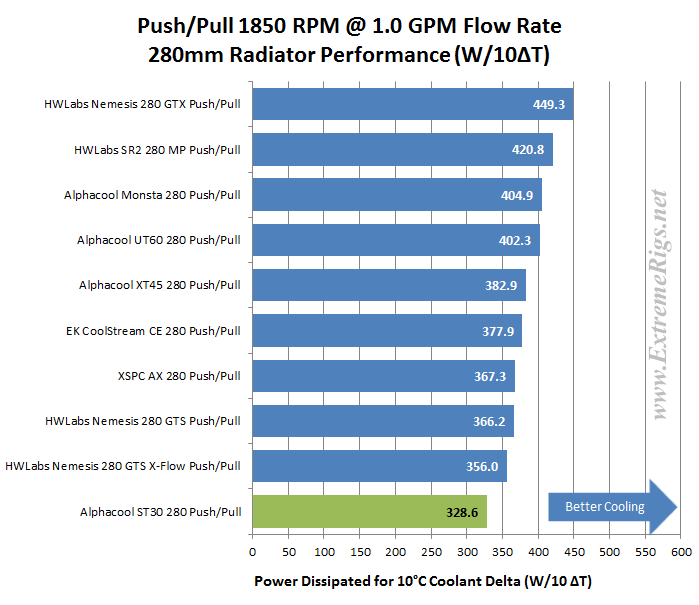 At 1850 rpm Push/Pull the ST30 280 takes another last place. At this data point it was a whopping 27% behind the first place Nemesis GTX and ~10% behind the best performing slim radiator.
At 1850 rpm Push/Pull the ST30 280 takes another last place. At this data point it was a whopping 27% behind the first place Nemesis GTX and ~10% behind the best performing slim radiator.
Another view of the same data, this time plotted as curves and some extrapolation added.
Be warned these plots can be hard to read given that many results are similar at the same data points.
Again the Push Only data first:
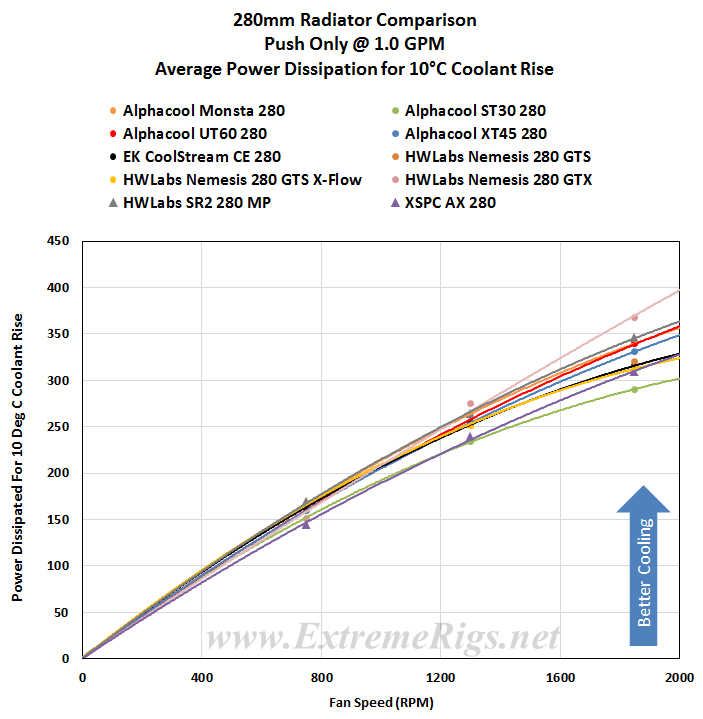 This perhaps best shows how close the results are, particularly with low speed fans.
This perhaps best shows how close the results are, particularly with low speed fans.
Because the data curves in plot above are almost blurred into one another, we have split it into two separate plots; 750 rpm to 1300 rpm and 1300 rpm to 1850rpm and zoomed in on those fan speed zones.
Now the Push/Pull results are plotted, again followed by split and zoomed versions.
ST30 280 vs. ST30 360
Before moving on let’s take a quick look at the thermal results for the ST30 280 and ST30 360 on the same plot. This is one of those “just for fun” plots because in reality we can’t make a 1 to 1 comparison between the two sizes because of the differing performance of the fans used.
The ST30 280 has ~10% less surface area than the ST30 360. Knowing that and the difference in fans used to test the 120.x and 140.x radiators, interpret the following as you will.
Push Only 750 rpm: ST30 360 was ~13% better.
Push/Pull 750 rpm: ST30 360 was ~7% better.
Push Only 1300 rpm: ST30 360 was ~10.5% better.
Push/Pull 1300 rpm: ST30 360 was ~7% better.
Push Only 1850 rpm: ST30 360 was ~11.5% better.
Push/Pull 1850 rpm: ST30 360 was ~6% better.
Which is an overall average of 9.75% better performance in favor of the ST30 360, which has a 9.25% greater surface area. That’s pretty cool right!
BUT, what I find most interesting is that The ST30 360’s Push Only results were almost equal to the ST30 280’s Push/Pull results.
Average Performance Factors
From every radiator tested we create APF “Average Performance Factor” charts from both the Push Only and Push/Pull results. We also make a combined plot of the average called the “Master Performance Factor”. The radiator with the best cooling ability (W/10ΔT) at each rpm is awarded a score of 100 and every other radiators W/10ΔT result is scored as percentage of the top performer.
This way of looking at the comparison takes away any advantages that a radiator may have at higher or lower fan speeds and looks at an overall average. While this appears fair it does tend to favor those radiators that are all-rounders and those radiators which do very well at high RPM. Most users should be more focused on their specific use case.
Here are the ST30 280’s APF percentage scores at each data point:
 The ST30 does have the thinnest core of the test group and we saw it’s W/10ΔT results, so we should already know what sort of results we are going to get here.
The ST30 does have the thinnest core of the test group and we saw it’s W/10ΔT results, so we should already know what sort of results we are going to get here.
As these percentage scores are relative to the best performer at each data point, we again advise readers to cross reference specifications and results for each radiator and keep in mind your case space available, intended fan assembly and operating speed.
The percentage numbers in the table above offer another way of looking at the ST30 280’s results. But for our scoring system we need a way to reduce the categories while retaining the data. To do this we average the results for each fan assembly type giving us Averaged Performance Factors.
Firstly – the Push Only APF:
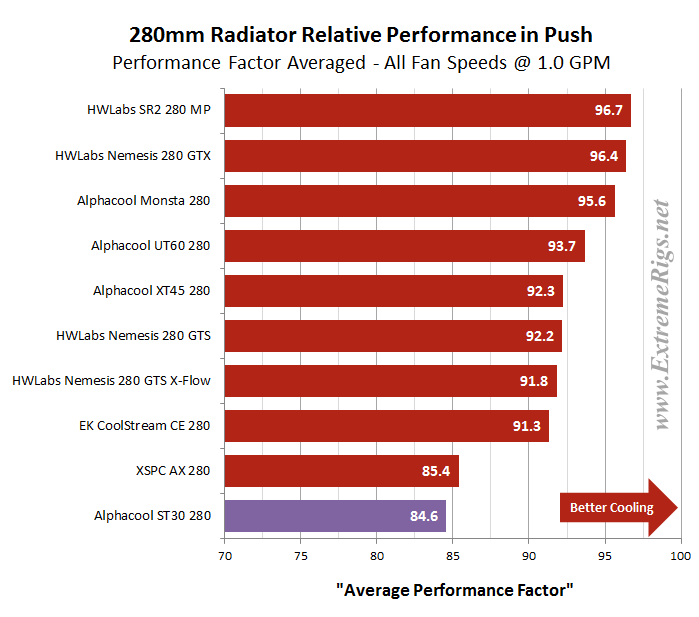 With an 84.6 % Averaged Push Only result the ST30 280 places last, very close to the AX280 which is 10mm thicker.
With an 84.6 % Averaged Push Only result the ST30 280 places last, very close to the AX280 which is 10mm thicker.
Now the Push/Pull APF:
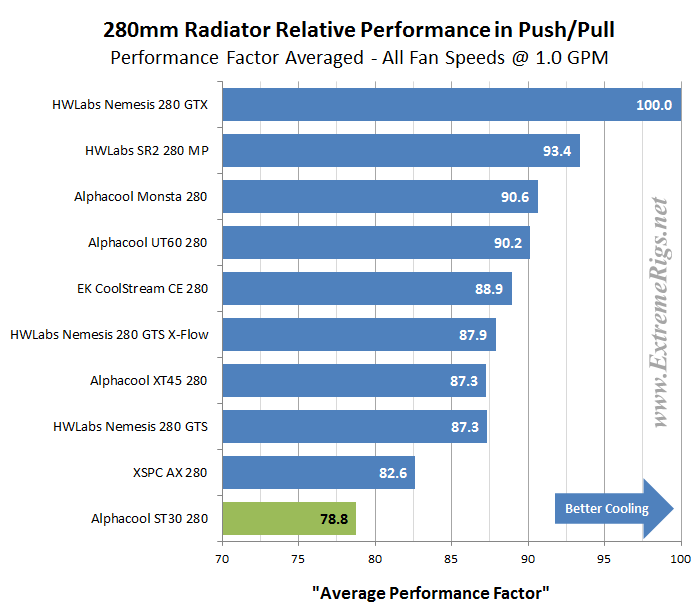 In the Push/Pull APF the ST30 280 again takes last place. Any weak points were somewhat magnified by the 100% score on the Nemesis 280 GTX. The very thin 16.5mm core of the ST30 380 is just not capable of dissipating as much heat as the thicker cored radiators.
In the Push/Pull APF the ST30 280 again takes last place. Any weak points were somewhat magnified by the 100% score on the Nemesis 280 GTX. The very thin 16.5mm core of the ST30 380 is just not capable of dissipating as much heat as the thicker cored radiators.
Finally we created the Master Performance Factor which is calculated from the averaged results of all the Push Only and Push/Pull thermal tests, at all fan speeds.
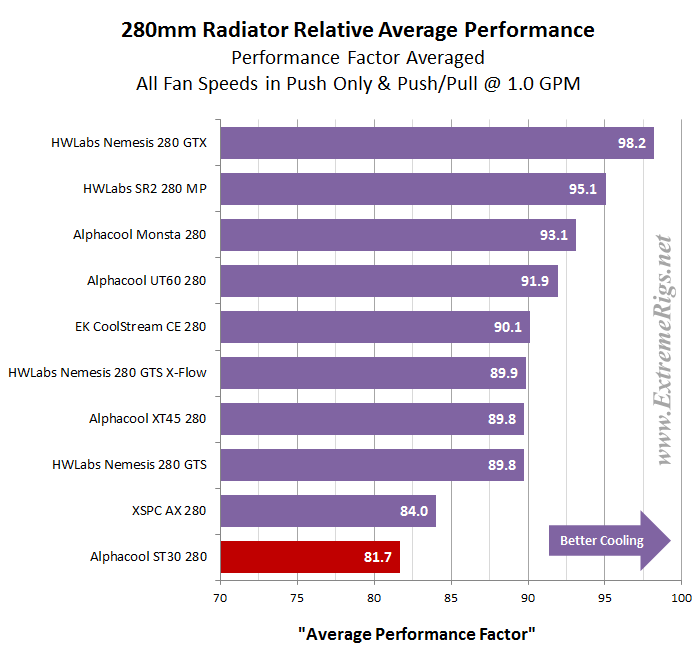 Finishing ~8% behind the best of the slim radiators, the ST30 280 is probably not an option those looking for maximum performance are going to be considering.
Finishing ~8% behind the best of the slim radiators, the ST30 280 is probably not an option those looking for maximum performance are going to be considering.
Space Efficiency
The ST30 280’s space efficiency vs. performance ranking is likely to be a breath of fresh air after being battered in the thermal performance rankings. Thinner rads almost always produce better results here than their thicker counterparts. We have used the Average Performance Factor results from the charts above to compile two plots which shows us how it compares to the other rads in terms of performance Vs. space taken.
First up is Radiator Thickness Vs. APF
Here the combined APF scores were divided by the radiator thickness only, with the highest (most space efficient) issued a score of 100. Each of the other radiators results was converted to a percentage of the most space efficient radiator’s score.
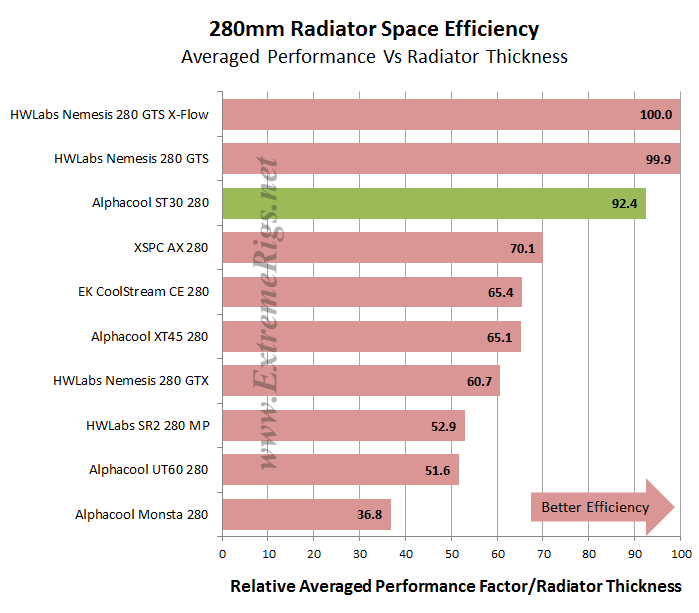 The order has ended almost in order of thinnest to thickest and as anticipated the ST30 280 fared quite well in this assessment. It’s 3rd place results was ~7.5% behind the winner.
The order has ended almost in order of thinnest to thickest and as anticipated the ST30 280 fared quite well in this assessment. It’s 3rd place results was ~7.5% behind the winner.
Next we took the APF results for Push/Pull and divided it by the total thickness including the fans and applied the same scoring system. For the Push Only we used the Push Only Vs Push/Pull comparative results and applied the same scoring system when compared against the Push/Pull.
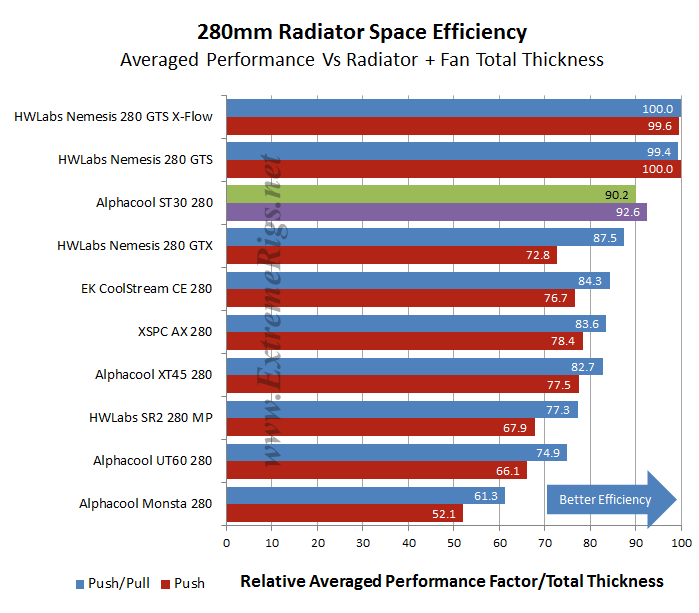 Again the results at the top of the table are the same with the ST30 taking 3rd place.
Again the results at the top of the table are the same with the ST30 taking 3rd place.
Value Factor
While our APF’s are still fresh in mind, let’s now look at the Performance Results vs Price to show which of the 280mm radiators might offer the best bang for your buck. Each radiator’s combined APF scores were divided by the radiator cost and again we applied our scoring system of percentage Vs. the best result of the category.
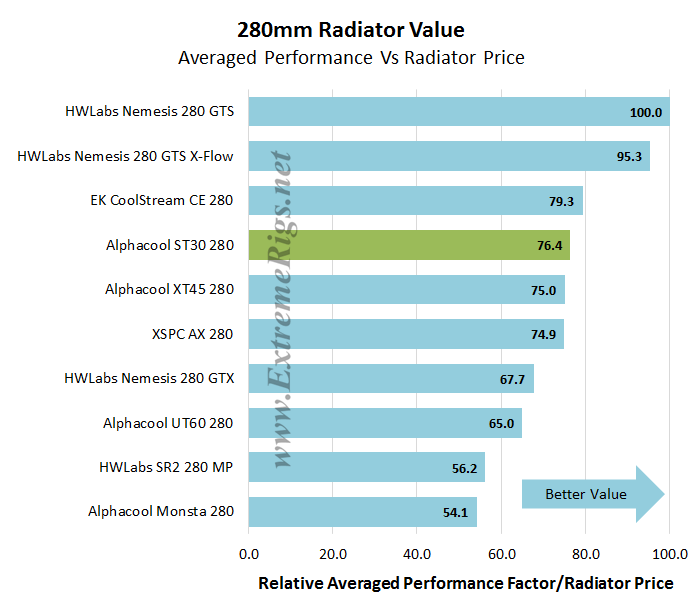 The ST30 280’s Value Factor turns out to be reasonably good, helped mostly by the fact it is the 3rd least expensive radiator of the test group. This tells us that it is reasonably good value for the performance potential it offers. While being ~23.5% behind the best value radiator, in reality the difference is not so great as the chart makes it appear, but when visualizing with percentages as we have done, the gap appears large.
The ST30 280’s Value Factor turns out to be reasonably good, helped mostly by the fact it is the 3rd least expensive radiator of the test group. This tells us that it is reasonably good value for the performance potential it offers. While being ~23.5% behind the best value radiator, in reality the difference is not so great as the chart makes it appear, but when visualizing with percentages as we have done, the gap appears large.
Generally value and space efficiency metrics usually correlate – thicker radiators which are generally better performing do contain more material after-all and so are usually also more expensive.
Next Up – Summary!
Summary
Thermal Performance
Thermal Performance scores are derived from the relevant Performance Factor scores. We set this scale with 75% and below as the 0 mark, with each 2.5% increase in relative performance adding 0.5 to the awarded performance score.
Note: Our test group of 10 radiators range in thickness from 29.5mm to 84.5mm with core density ranging from 9 FPI to 21 FPI. This greatly differing array of samples means that the better performing thicker radiators (generally speaking) will actually make the thinner radiators scores appear worse. This is an unavoidable side effect of the scoring system and we again advise readers to focus on radiators which are suitable for the specific case scenario. Depending on the amount of variance in the results, this could end up with misleading scores based on the comparative performance.
Push Only Thermal Performance
- 2/5
The ST30 280’s Push Only APF result of 84.6% translated into a performance score of 2/5.
While it was competitive at the 750rpm data point, it is best suited for medium fan speeds. Unfortunately it was out-muscled by the thicker cored radiators.
Push/Pull Thermal Performance
- 1/5
The Push/Pull APF result of 78.8 translated into a thermal performance score of 1 out of 5. The Nemesis 280 GTX which scored a perfect 100 in this category with outstanding thermal results pushed all the other rad’s scores down. Having said that, the ST30 280 was still ~11% behind the best of the slim radiators.
Overall Thermal Performance
- 1.5/5
The Master Performance score of 81.7 generates a well below average performance score of 1.5/5. This system generated score seems reasonably fair given that the ST30 280 finished among the bottom 3 results in all 6 thermal tests conducted. Again the Nemesis GTX pushed many other radiator’s scores lower having an APF result of 98.2.
Performance is not the be all and end all factor in making a purchase decision, though for many it is high on the selection criteria.
Because the ST30 is so thin it did score quite well in our Space Efficiency and Value metrics, taking 3rd place in both those comparisons which do factor in thermal performance..
Features & Quality – 2/5
The ST30 280 has steel side panels which keep this very thin radiator from feeling flimsy. The end tanks are brass with copper tubes and fins which are spaced quite evenly. The satin black finish is excellent and we are very pleased that Alphacool radiators now have internal cleanliness which is acceptable.
The 29.5mm overall thickness of the sample is hard to overlook as the dominant physical characteristic of the ST30 280. Furthermore the core is just 16.5mm thick which is very thin indeed and is the main contributing factor to it’s heat dissipation potential.
The ST30 is only fitted with 2 x G 1/4 ports which is a little uninspiring, but of more concern is that the placement of the ports means many fittings can not be used when a fan is fitted to the port side of the radiator.
Tube protection plates are fitted which we always like to see, however the fan screw holes above them were a major problem on the ST30 280. Due to the holes being out of square and the spacing being inaccurate meant that fans ended up attached a bit crooked and only 3 screws could be used to attach the fans.
The thin core was best suited to medium speed fan assemblies which makes sense given it’s 16 FPI fin spacing.
The ST30’s medium restriction level will not pose any issues for pump power requirements when planning out a loop of average size containing the usual components.
Summary – 2/5
Extreme Rigs is an independent review site, however we do rely on our sponsors continuous and generous support to keep bringing you the reviews we do. Occasionally we have a product come across the review benches which after thorough testing and scrutiny just does not meet our expectations. We firmly believe that we are correct in continuing to publish our findings based on what we observe. We understand that sponsors may get frustrated with our review style and some companies have ceased to communicate with us because one of their products may have received some unfavorable results and/or comments in a review.
We sincerely hope that will not be the case with Aqua Tuning and Alphacool who have both been fantastic long term sponsors.
Today we had one of those products which failed to meet expectations in many aspects. Occasionally quality control issues get missed at manufacturing and we accept that is part of business. We would still welcome another sample to compare to the one we already have and advise readers of our findings. If nothing else it proves that review samples are not “cherry picked” for reviewers (at least not in this case).
The NexXxos ST30 280 from Alphacool proved to have lack-luster performance in all of our thermal performance tests. This is due to it having the thinnest core which is just not capable of great heat dissipation. In fact it proved to be the worst of the test group and was a considerable margin behind even the other slim 280mm radiators. The Space Efficiency and Value metrics were more favorable for the ST30 280mm so there were a couple of positives based on it’s thermal performance results.
The finish on the ST30 280 is very good and we really like how clean the internals of the current Alphacool radiators are. The shape of the radiator is very traditional with it’s two exposed end tanks which have just one set of G 1/4 ports.
Unfortunately those good points are overshadowed by some poor execution at manufacturing with the fan mounting holes being so far out of whack that a full set of screws can not be used when attaching a fan. Additionally what I would call a design oversight has the ports placed so close to the core that many fittings can not be installed when fans are fitted on the port side. If this was a radiator I had purchased, I would be taking it back and looking for a different option.
The ST30 280mm is not a radiator we can recommend as there are superior performing slim radiators available, but more importantly there are issues with the design and quality control which need addressing.
We hope to be able to bring you an update in the near future if/when another review sample is approved.
Where to buy:
- Aqua Tuning : Black $71.41 (incl. VAT) + shipping
- Aqua Tuning : Black €67.99 (incl. VAT) + shipping




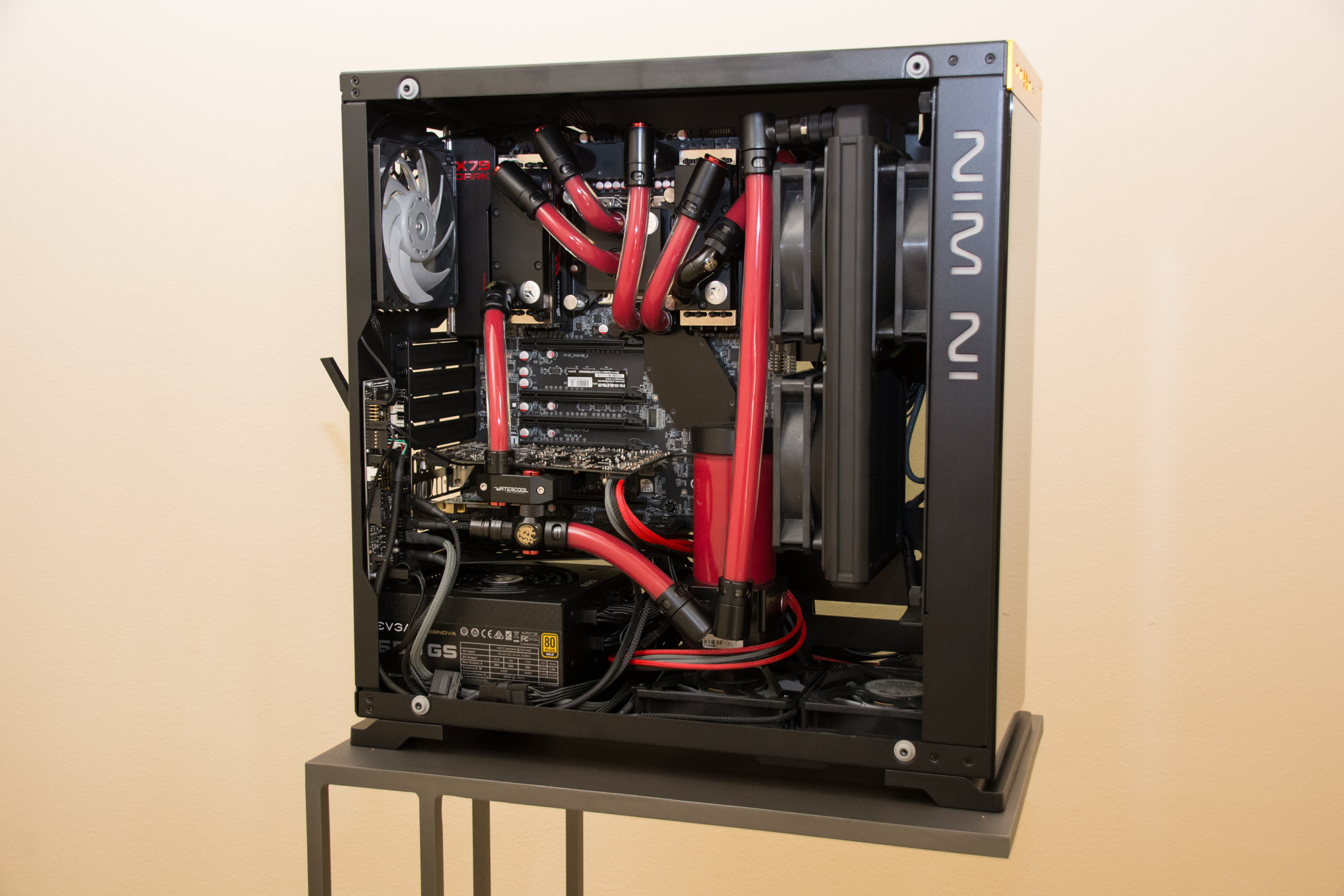
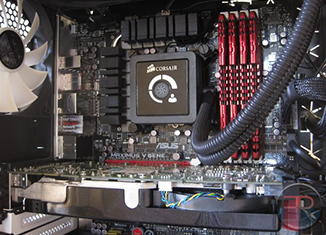

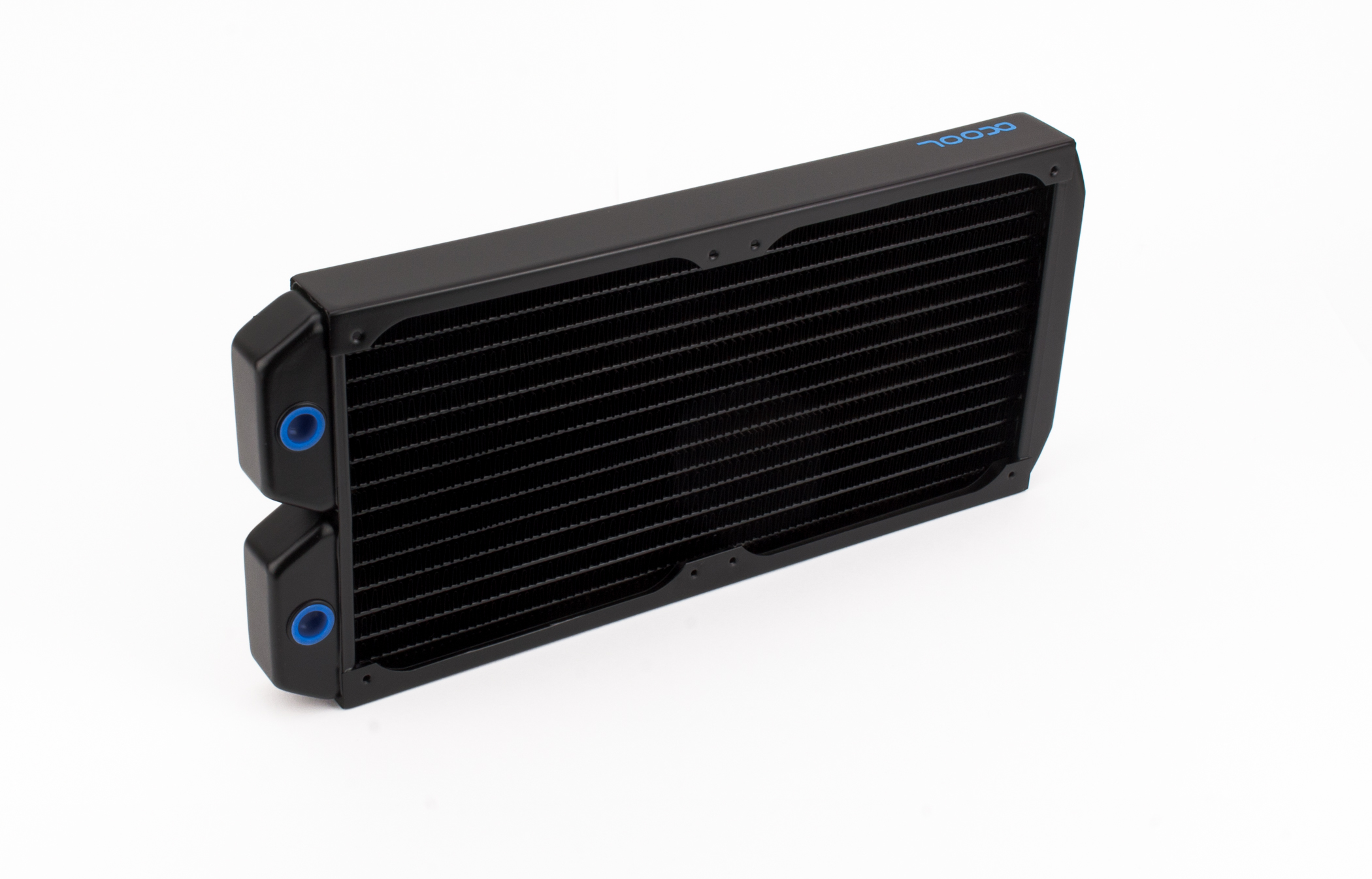


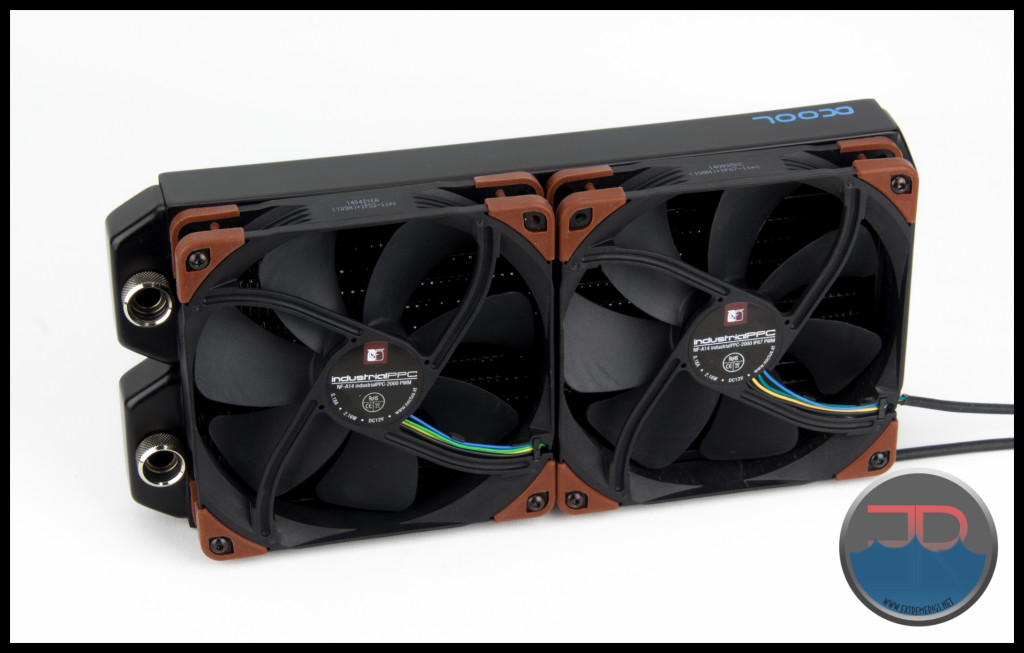
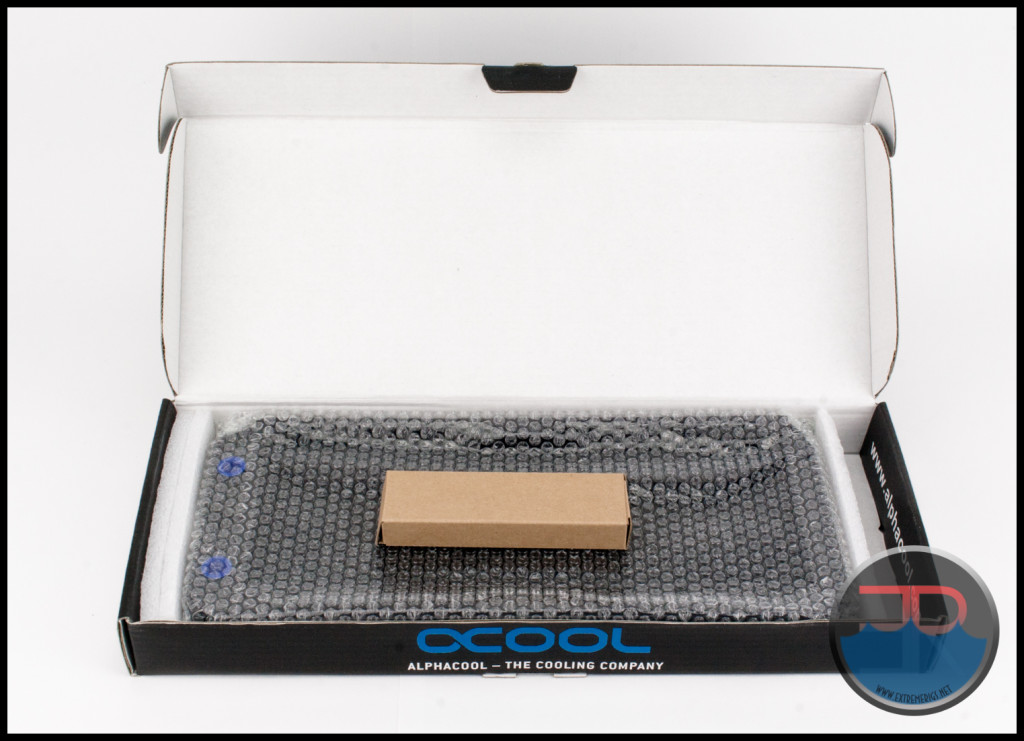
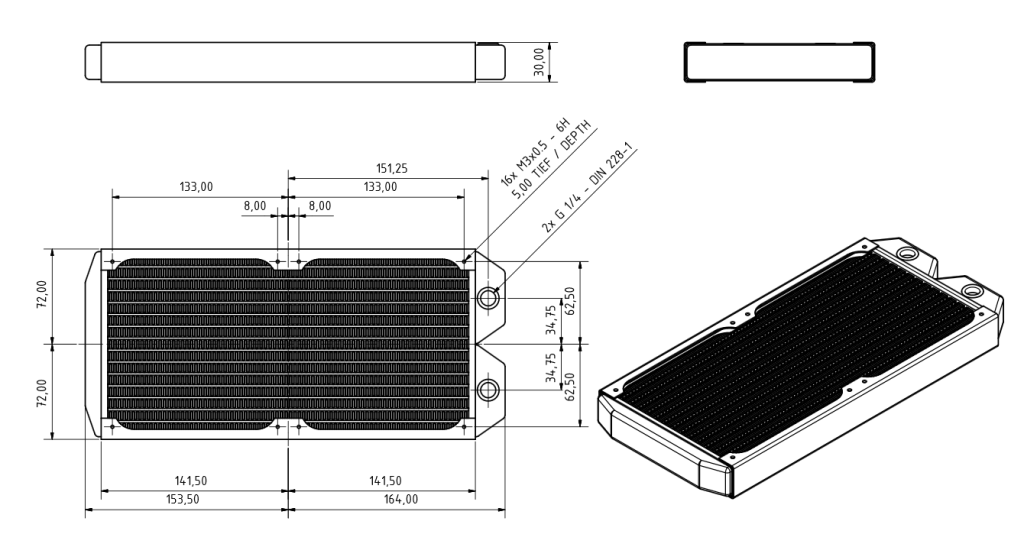
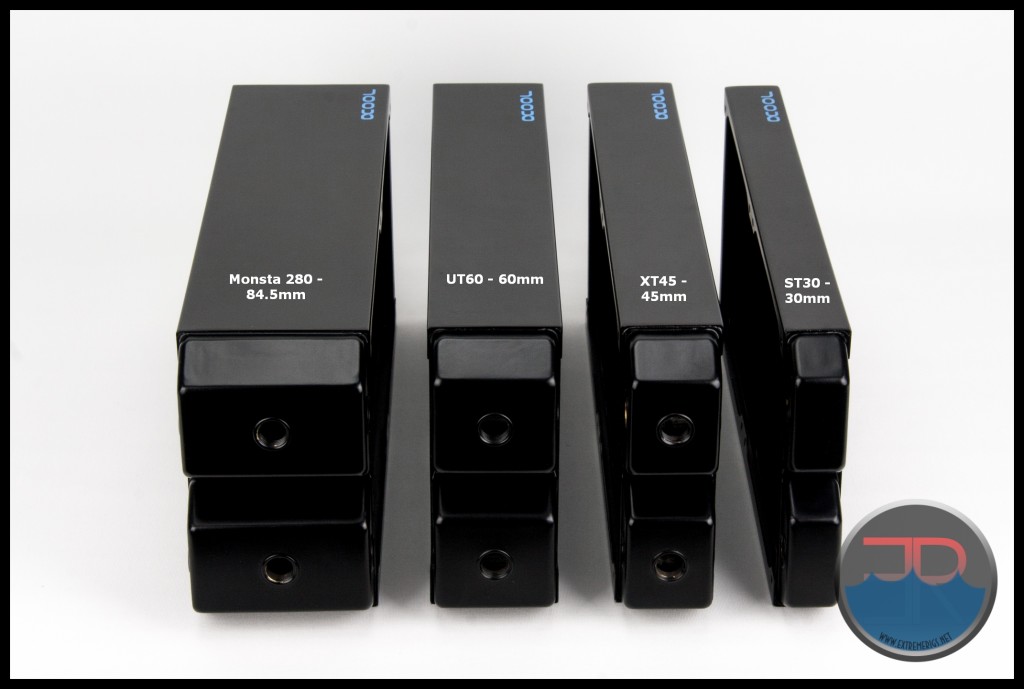
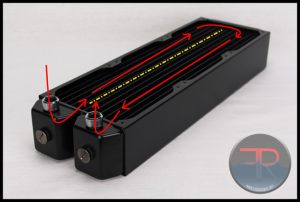
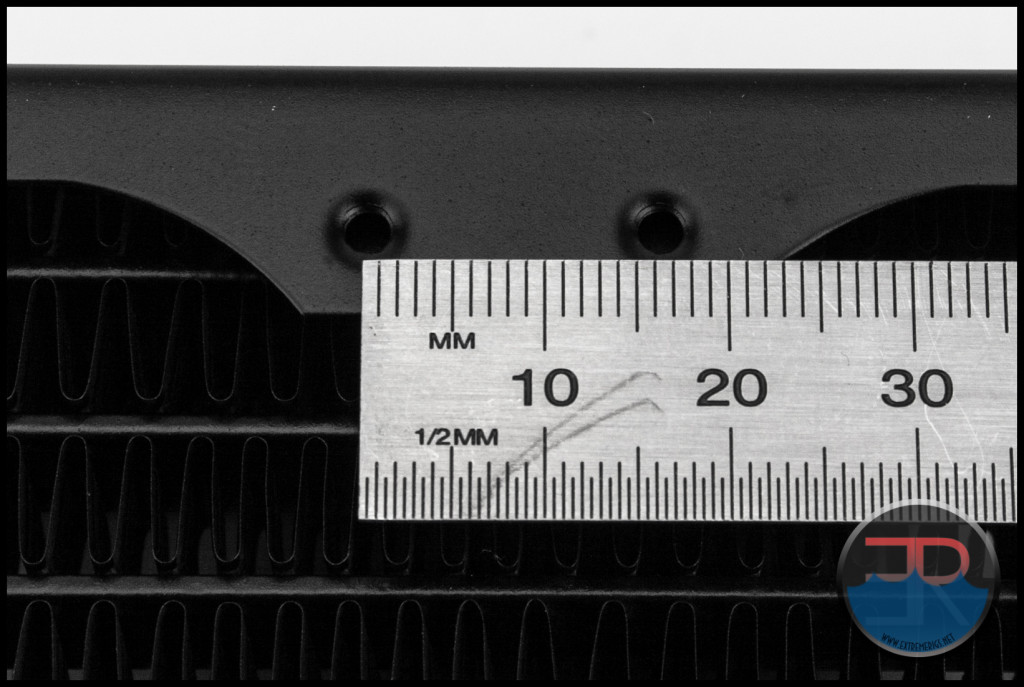
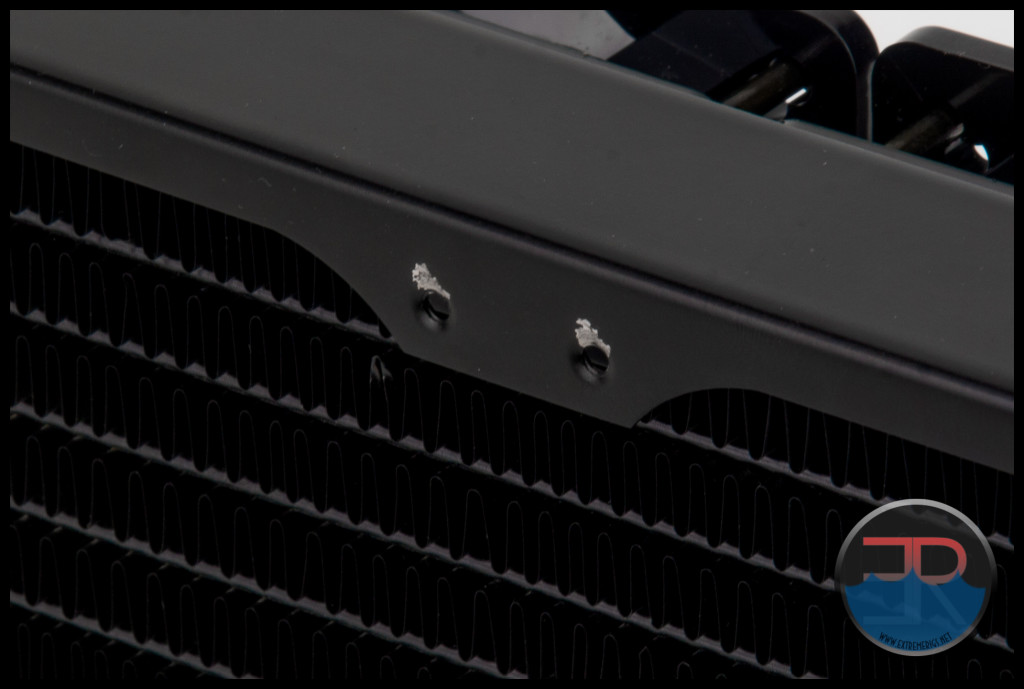
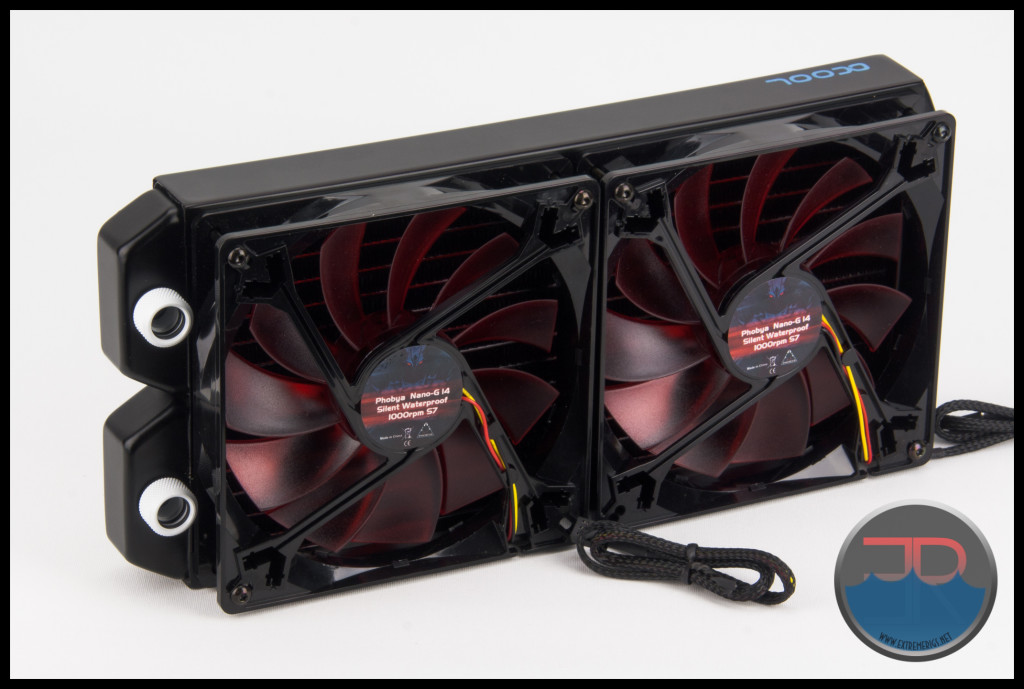
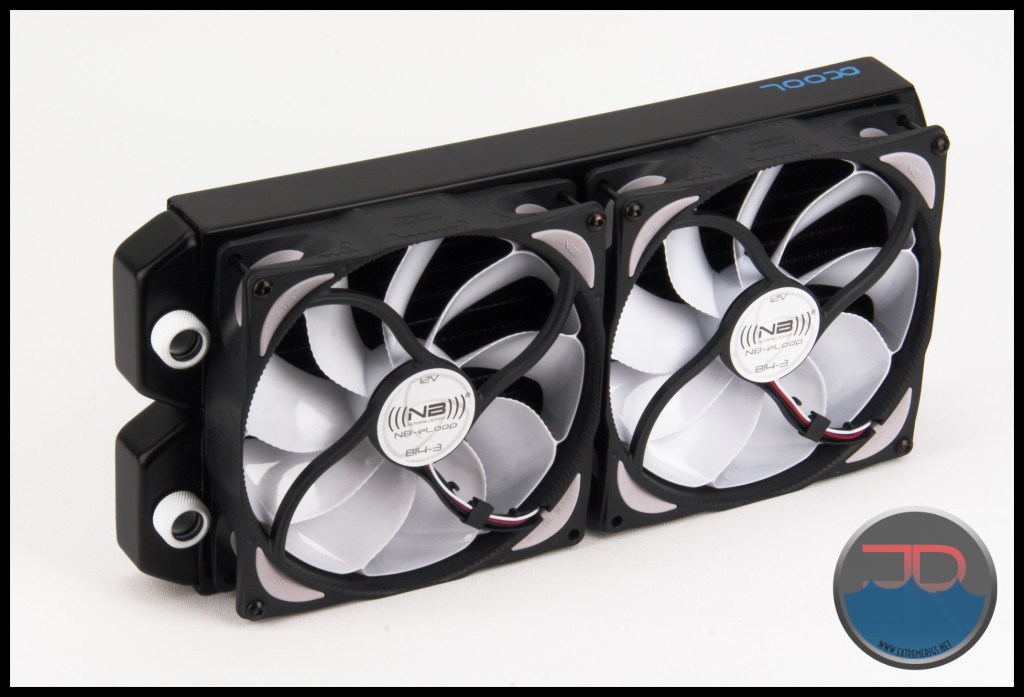
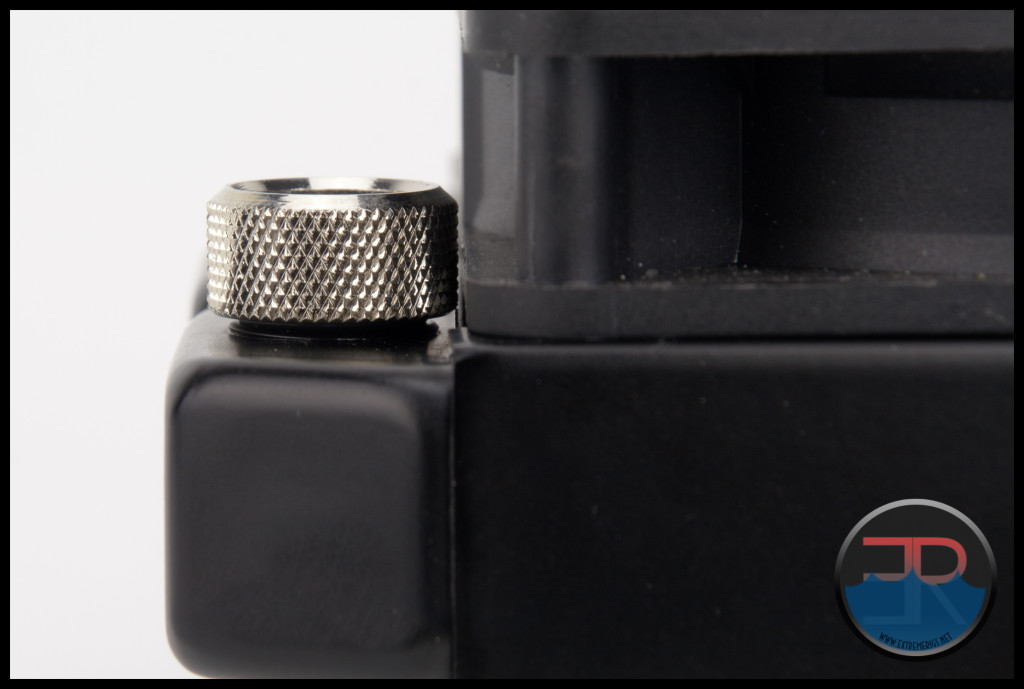
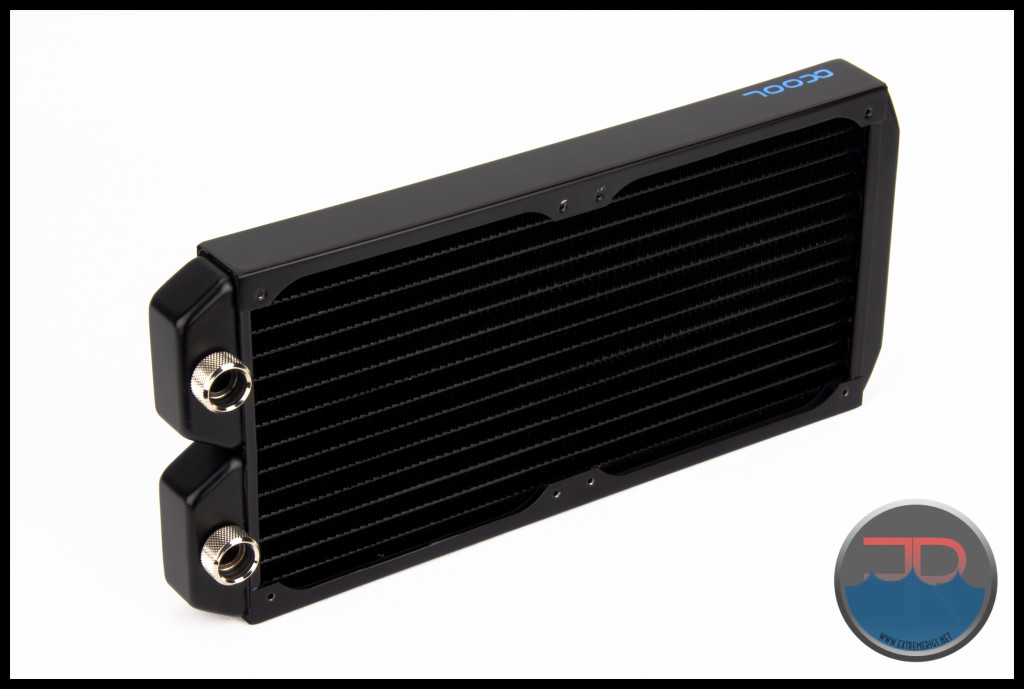
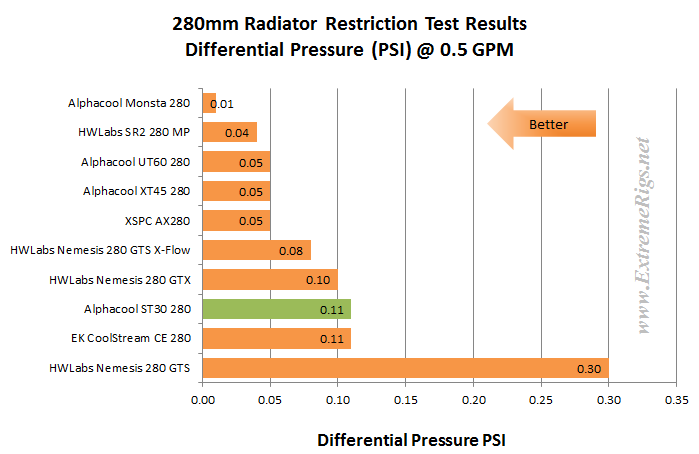
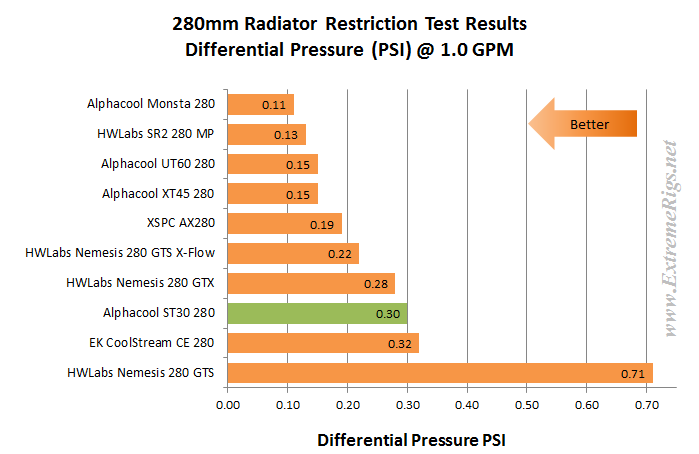
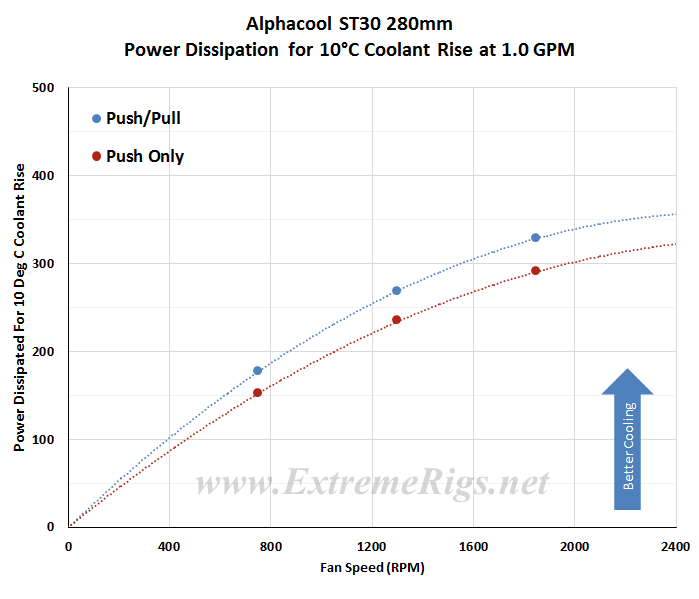
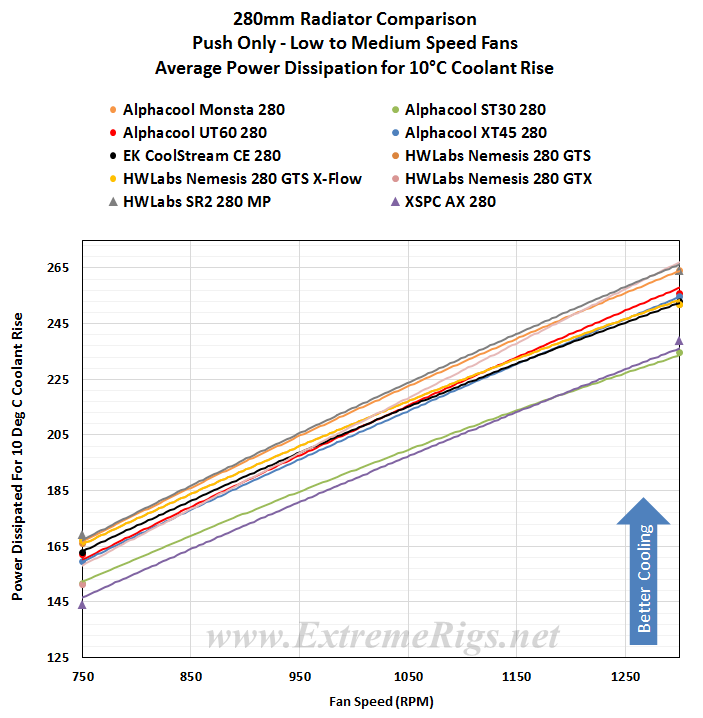
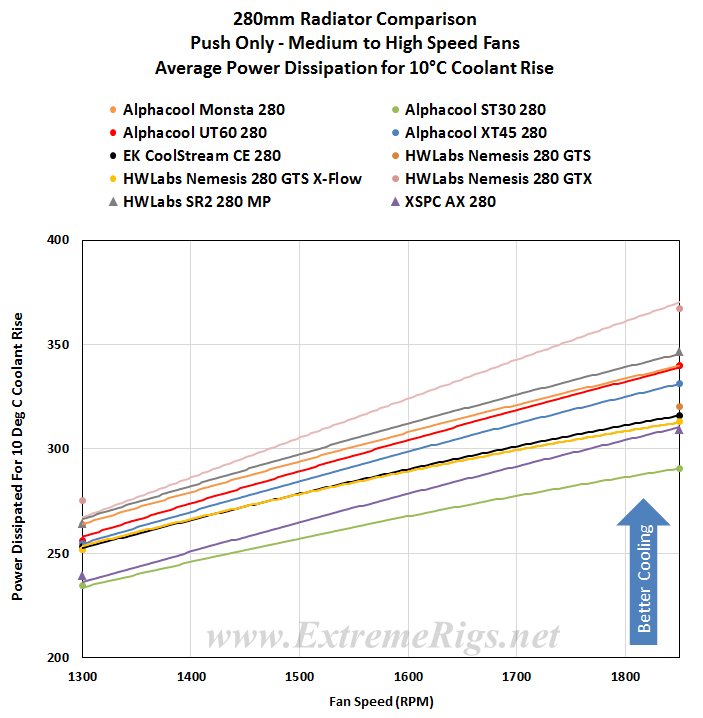
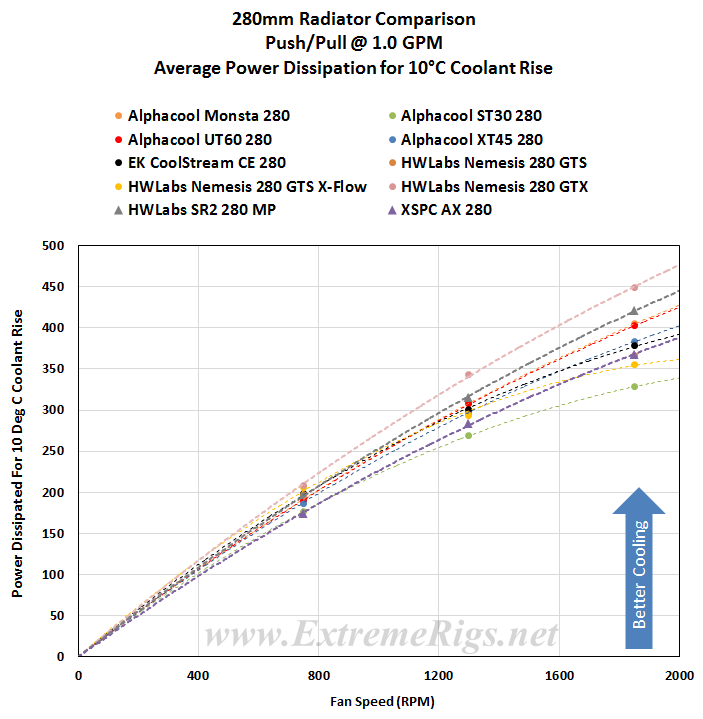
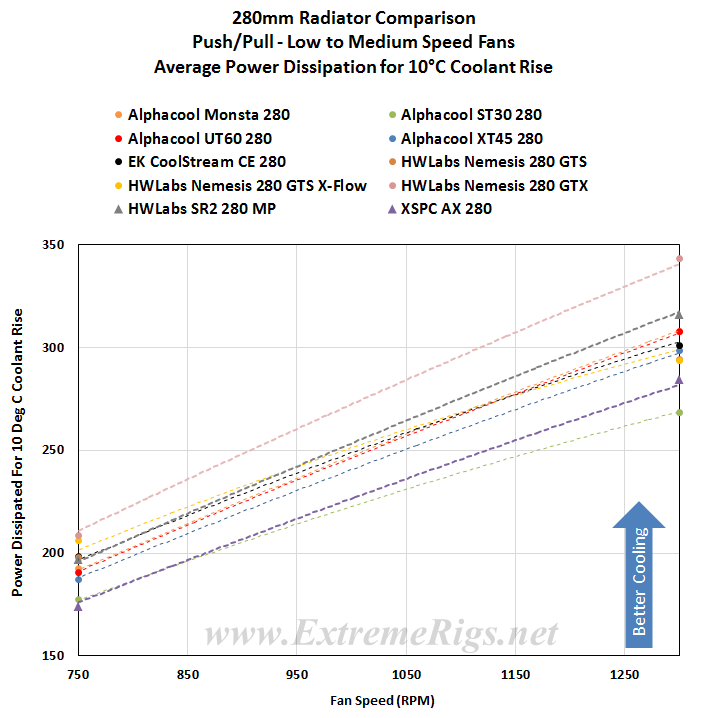
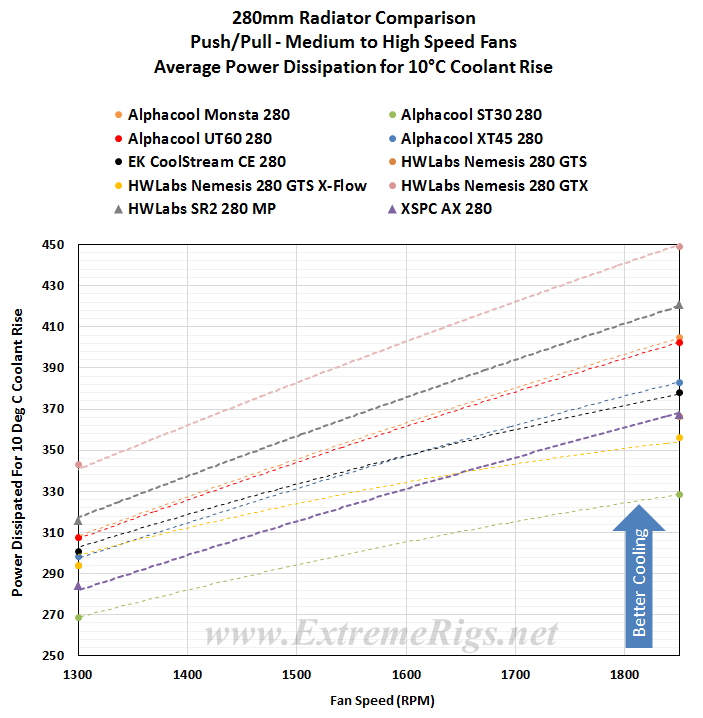
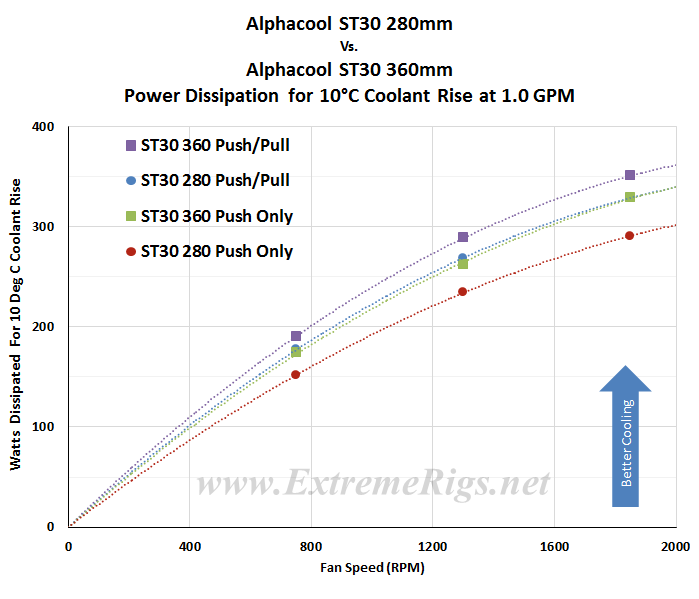
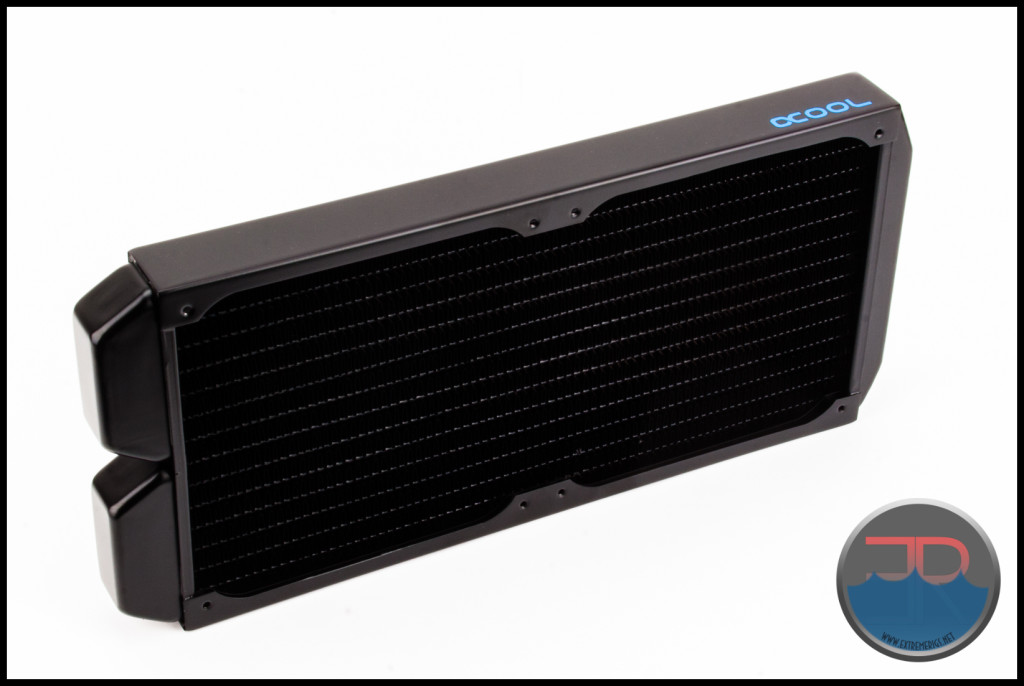


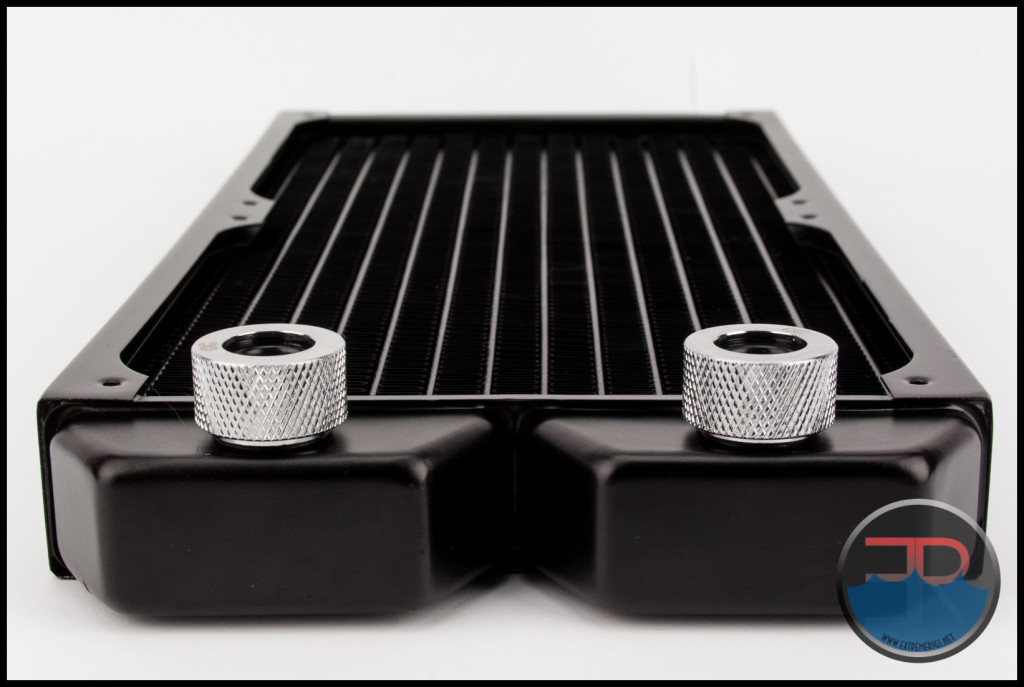
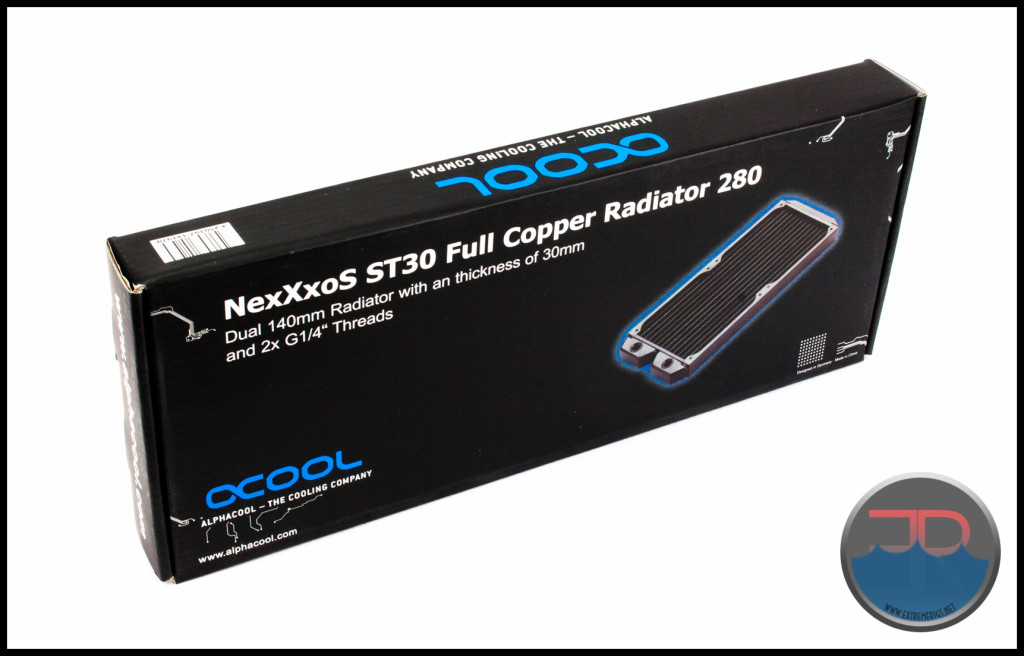

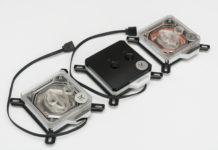

[…] Alphacool ST30 280 Radiator Alphacool UT60 280 Radiator Review Alphacool Monsta 280 Radiator EK CE 280 Radiator Hardware Labs Nemesis GTS 280 Radiator Hardware Labs Nemesis GTS 280 X-Flow Radiator Hardware Labs Nemesis GTX 280 Radiator Hardware Labs SR2 Radiator XSPC AX 280 Radiator […]
this rad is very special in a way that it’s probably the smallest 280 rad. it’s not only thinner, it’s also shorter and narrower than other 280 rads. for example it is almost 1cm narrower than HWLabs GTS 280. this small size allows to use it in systems were no other 280 rad will fit. for example in Fractal Design Define S/C series of cases, only alphacool 140/280/420 rads will fit the front. so it performs quite well considering the size.
what i’d like to see is the performance comparison with 240 rads
Comments are closed.